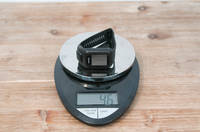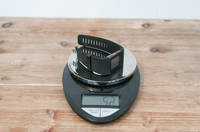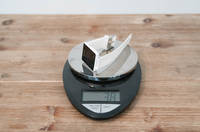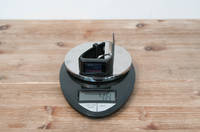Garmin Vivoactive HR In-Depth Review
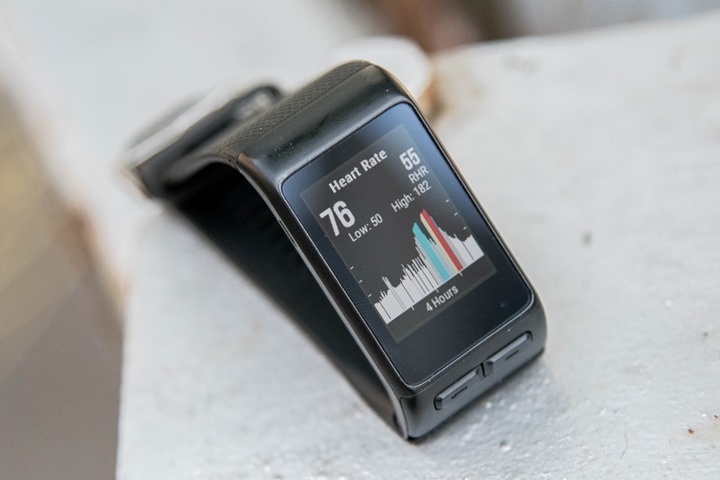
It’s been a few months since Garmin announced the Vivoactive HR while at Mobile World Congress in Barcelona. The unit started shipping last month and I’ve been wearing it on my wrist 24×7 since then. The Vivoactive HR sits in Garmin’s mid-range watch pricing scheme, at $250. It’s a bit of a Swiss Army knife in terms of functionality. It can track runs, rides, and swims – heck – even golf, skiing, and rowing. It’s not top of the line in any given category, but it’s still quite suitable in many categories.
After a month of using it, I’ve got a pretty good idea of what works well…and what kinda sucks. More than that, I’ve got a much clearer idea of who exactly this watch is best for, and how it ranks up against other competitors.
Before we get going, note that Garmin did send over this unit (a final production device) as a loaner. After I’m done here I’ll send it back to them in Olathe, Kansas – just like normal. Then I’ll go out and get my own. So, if you found this useful, hit up the support links at the end. With that – let’s dive into it!
Unboxing:
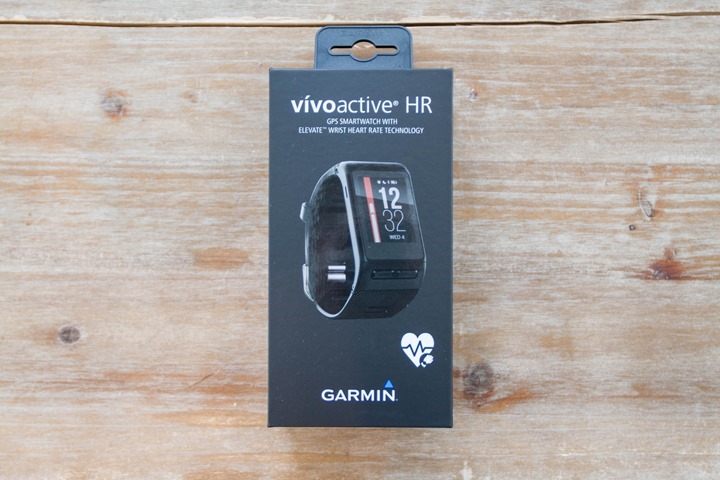
I like simplistic unboxings. And this falls quite nicely in that category. In case you’re wondering what doesn’t fall well into that category, it would be most action cam unboxings. They tend to have boatloads of mounts, attachments, and small parts that take forever to photograph.
We’d slide the interior of the box out slowly, revealing the watch below. You can add Barry White music here if you’d like.
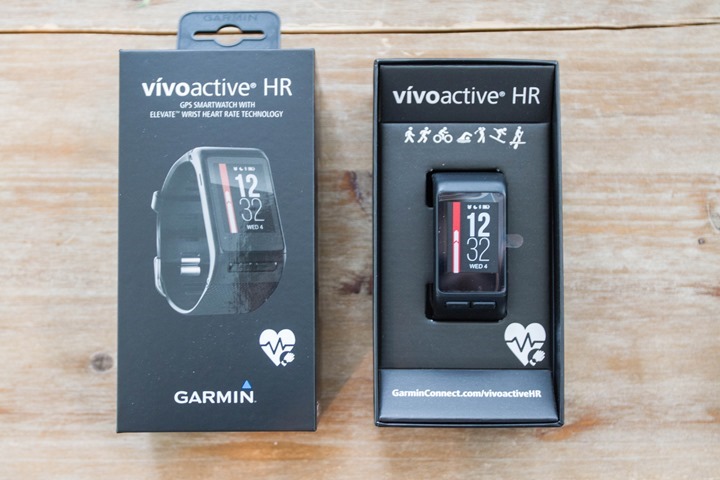
Inside the box you’ll find just three things: The watch, a charging/sync cable, and some paper junk.
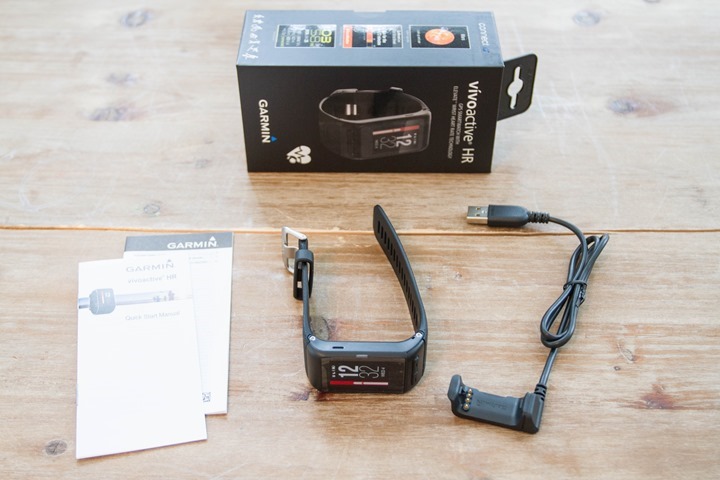
First we’ll start with the paper junk. This just tells you all the things not to do with your watch. It also lets you know what you can’t blame Garmin for later.
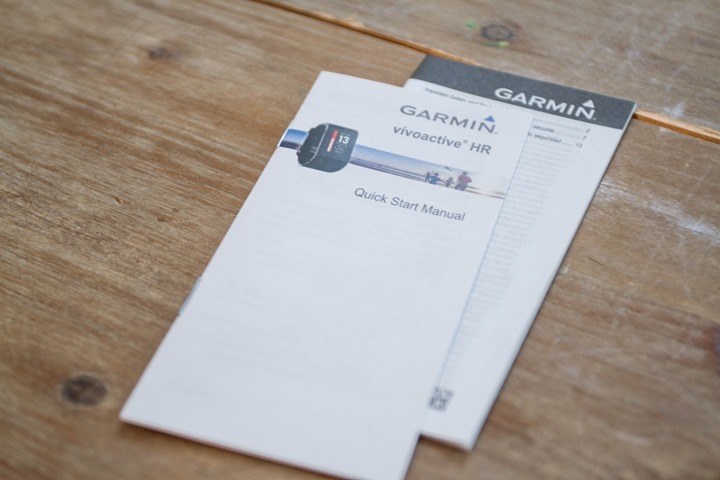
Then we’ve got the watch itself:
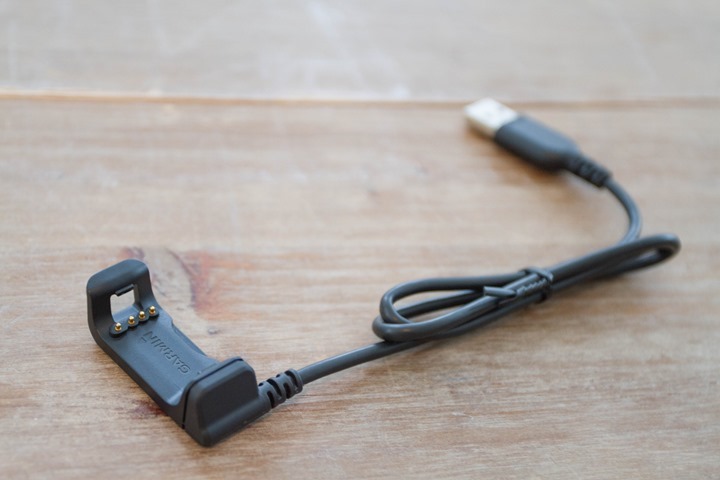
You’ll see the optical HR sensor on the back.
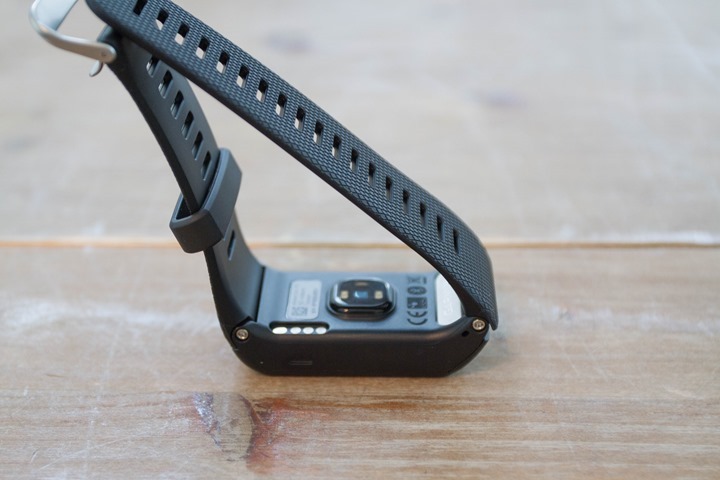
Also, note that the bands can detach in the event they need to be replaced due to unnecessary roughness on your part.
Finally, the charging clip. This will give it juice, but it also allows you to sync/download over USB in the event you’re smartphone-less.
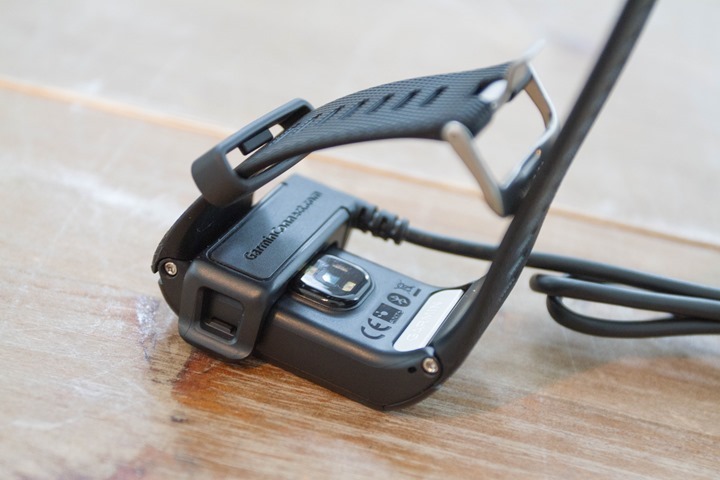
What’s that? You want a video version of the unboxing instead? No problem – here ya go:
While I do some size comparisons in that video, let’s move along to photographic-based comparisons.
Weight & Size Comparison:
When it comes to size, the Vivoactive HR is definitely quite a bit different than the original Vivoactive. For starters, the original Vivoactive was all about size. And not in a big way – but in the ‘be the smallest GPS device ever’ kinda way. And it did well there. Except such a size doesn’t yet permit adding an optical HR sensor. So the unit got a bit chunkier:
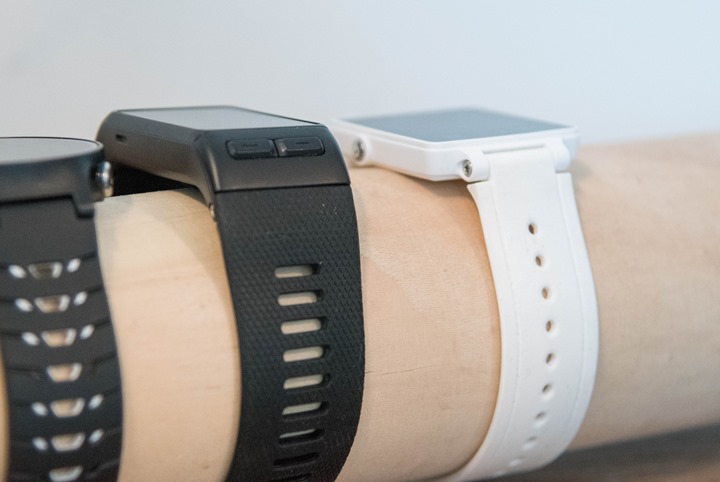
In many ways, the unit is very similar in size to the Fitbit Surge. The Vivoactive HR maintains the same depth across the entirety of the unit, whereas the Fitbit Surge is deeper at one end, and shallower at the other. On the face of things though, they’re pretty similar:
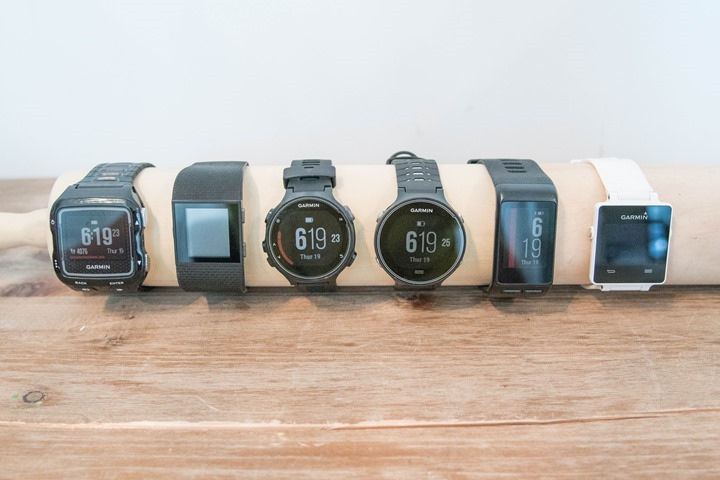
(Left to right: FR920XT, Fitbit Surge, FR735, FR630, Vivoactive HR, Vivoactive original)
You can see above that the Vivoactive HR & Fitbit Surge are skinnier than most round-faced watches (or the wider FR920XT). However from a depth standpoint, it’s about the same (all skinny):
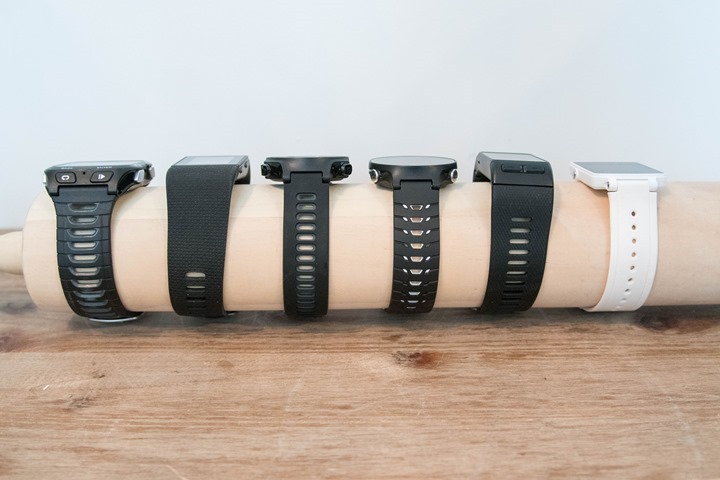
In fact, to demonstrate this I put these four watches in a row (Vivoactive original, FR735, Vivoactive HR, FR920XT):
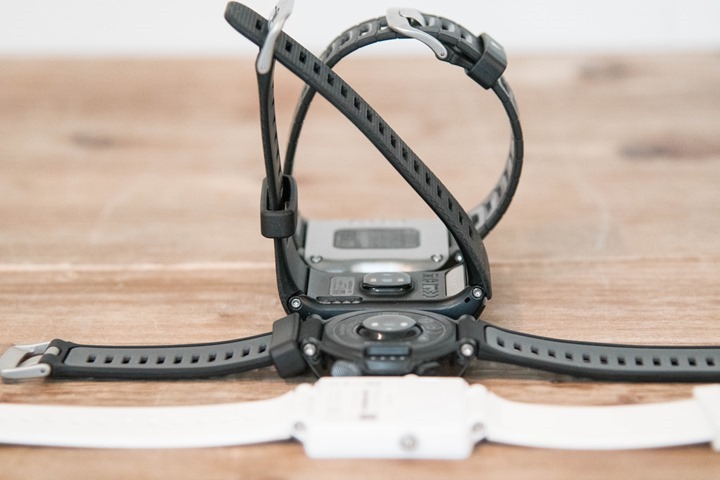
Then, I lowered the camera equal to the table. The original Vivoactive is obviously much skinnier, but the FR735XT, FR920XT, and the new Vivoactive HR are all virtually identical. The focal point in this picture is on the HR sensor of the Vivoactive HR:
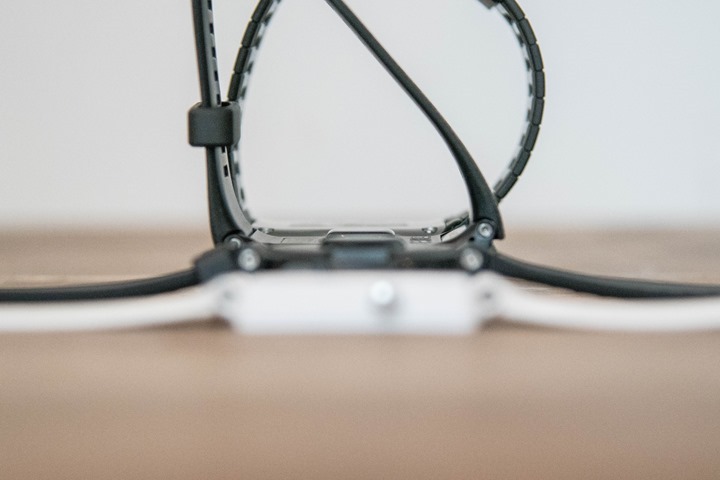
What’s interesting though is that while the Vivoactive HR screen appears bigger than the original Vivoactive, the underlying displays are actually identical. What’s not identical though is the new touchscreen layer used on the Vivoactive HR. Also, the screen is rotated 90°. The new touch layer along with a refreshed user interface gives the watch a brighter and crisper feel. Something that some lamented the original Vivoactive lacked (felt dim/dull).
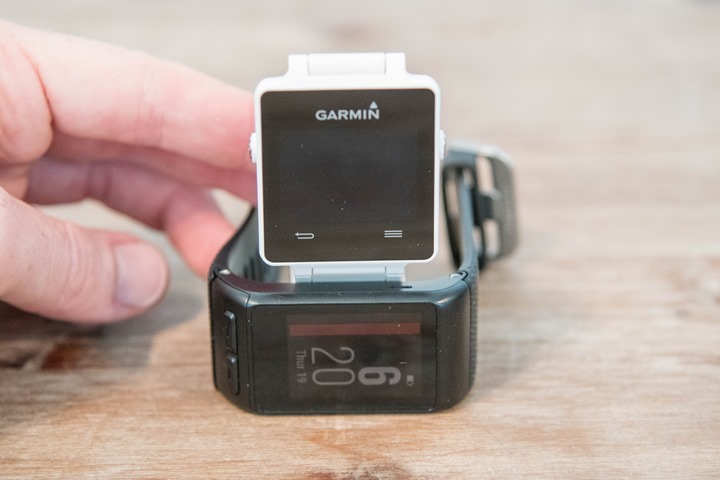
Also, on the new Vivoactive HR you can adjust the backlight brightness, should you wish to.
As for weights, ask and you shall receive:
Left to right: TomTom Spark, Fitbit Surge, Garmin Vivoactive original, Garmin Vivoactive HR
Ok, enough sizing around – let’s get onto using the darn thing.
Activity Tracking & Sleep:
Given the very base of the product name is ‘Vivo’, it stands to reason that in the Garmin world that means that it comes from a long lineup of activity trackers (Vivofit, Vivoactive, Vivosmart, Vivonachocheese, etc…). The Vivo lineup was historically based in step and general activity tracking, including sleep. And that’s all true today, except it’s been extended to include automatic exercise recognition, called Move IQ. But before we get there, let’s talk basic steps and sleep.
The Vivoactive HR will track your steps using the accelerometer inside of it. It does this 24 hours a day. You can see your steps for the day by just swiping the screen to the steps widget. That also shows you distance walked and floors climbed.
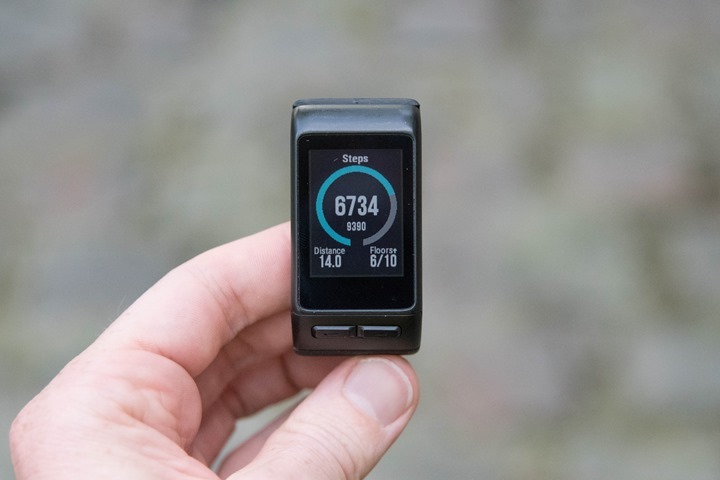
You can tap that and get a weekly graph of steps or floors:
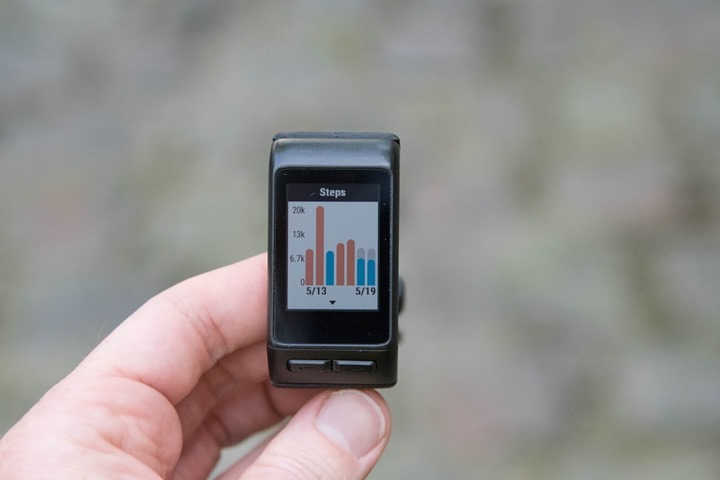
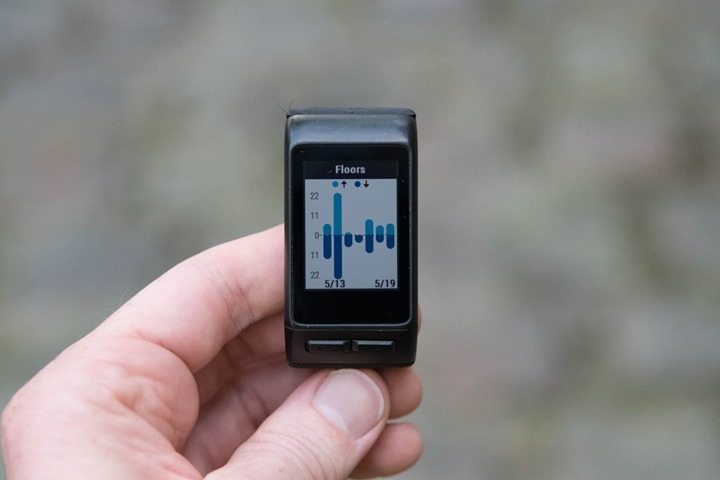
The floors climbed metrics is measured by the barometric altimeter internal to the watch. The idea being that when you go up vertically at the same time as you walk, it means you’re going up stairs. It can also could mean you’re pacing in circles in an elevator though. Still, for the most part I found it worked fairly well and I got far fewer false positives in elevators than I have in the past on other devices.
While inactivity alerts are commonplace now, they weren’t always the norm. Garmin has long had their inactivity bar, which fills up in chunks of red over the course of an hour if you’re lazy. You can see it along the left side.
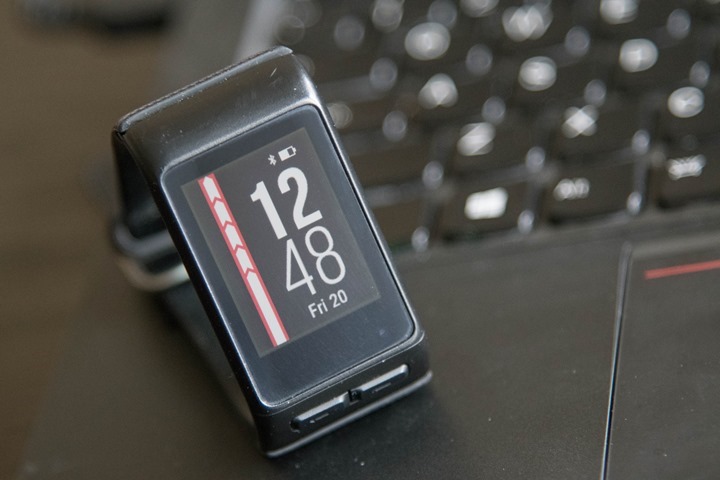
The inactivity bar is cleared by walking about 100-150 meters. While I had some issues with this until today on my unit, yesterday’s firmware update appears to have fixed the incorrect clearing of the move bar that I saw. I’ve never had issues with feature in past Garmin devices, so hopefully this was just a one-off bug.
Below, you can see the inactivity chunks cleared off the red bar – this means that I’ve walked the required distance.
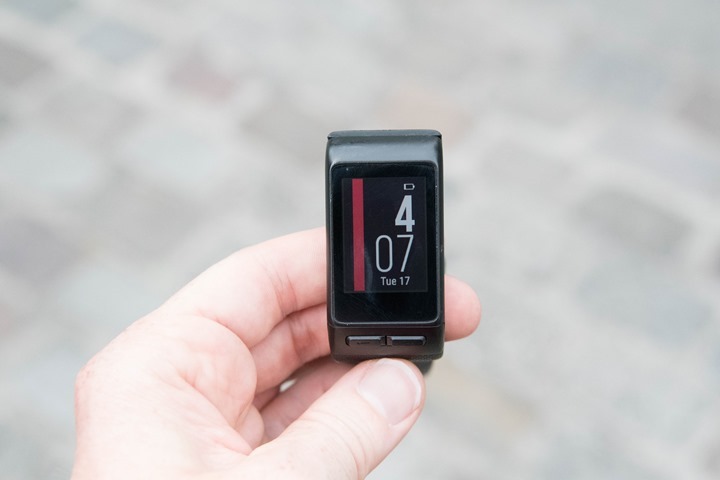
Next is intensity minutes. This was introduced last year within Garmin wearables, and is designed to motivate you to reach a goal of 150 minutes of exercise per week. Basically, activities that get your HR up. That follows general health recommendations of 5 days of 30 minutes of exercise each week. So, 5*30 = 150. You can swipe to see your intensity minutes at any time:
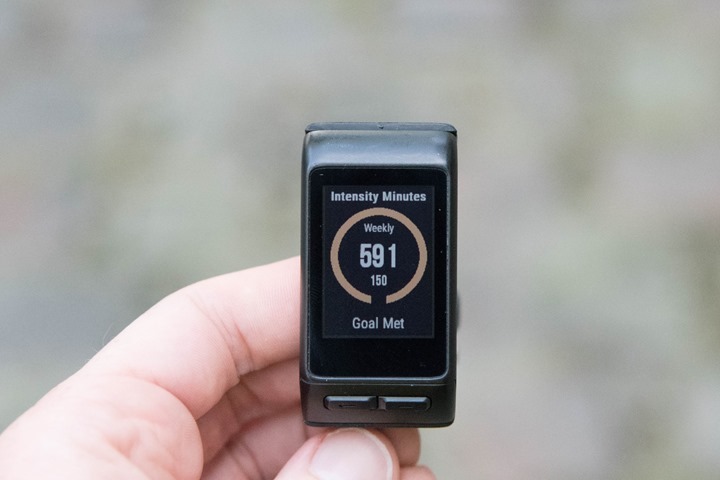
I’ve seen a bunch of weird numbers shown for the intensity minutes. At one point earlier this week I could sit on the couch and manage to get intensity minutes to accumulate. However, with the firmware update yesterday, I seem to be good again and I’m no longer receiving credit for being a couch potato (for better or worse).
Like with the other widget pages, you can tap on them to get an overview of the week.
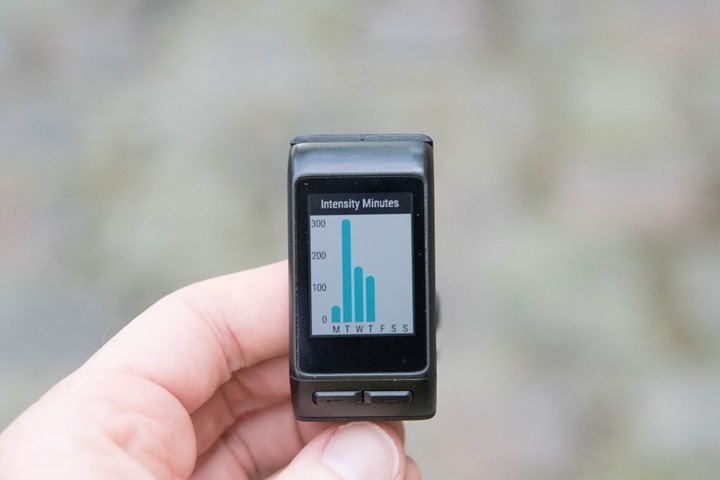
Next we’ve got Move IQ. This is also new, and the first Garmin device we’ve seen it enabled on. The idea here is automatic exercise recognition, even if you forget to press the start button in an activity. Now there are some limitations. First is that it’s not going to be super precise. It’s really designed to capture walks and rides around town, more than it is designed to capture a detailed workout. While you’re using the unit, there’s no interface to see the Move IQ data being captured. Instead, it all happens behind the scenes. The only way you can see the Move IQ captured ‘workouts’ is on the calendar page (a 1hr walk in this case):
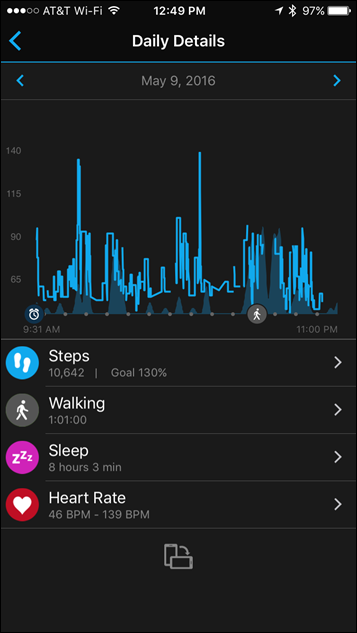
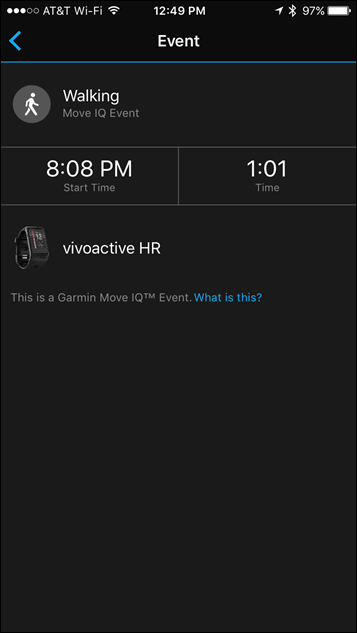
As you can see, there’s no distance displayed for activities like cycling, swimming or walking. Instead, just duration. That’s because the unit doesn’t enable GPS. This is purely accelerometer based. The next challenge is that it’s only listed in the calendar view on the app. I have no idea why it doesn’t show up as workouts/activities like it does on other platforms (Fitbit, Withings).
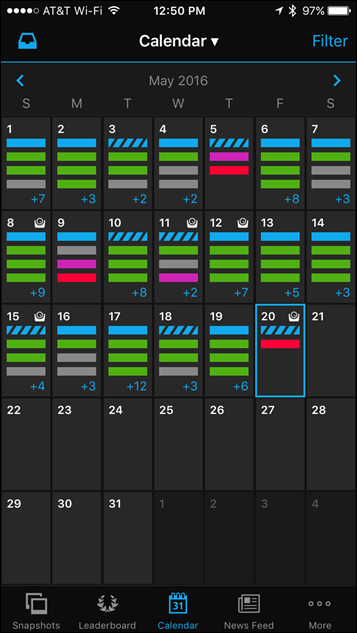
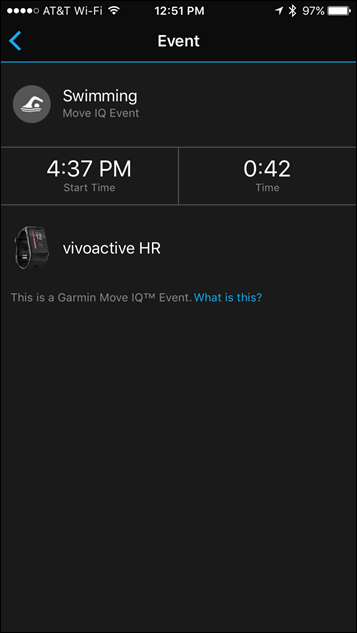
Still, I do find it useful for better quantifying those long walks and quick rides around town. These being activities that I don’t tend to start the GPS for, since I don’t typically find it worthwhile.
Note that I definitely wouldn’t use it for any of my workouts. I want precise accounting of that, and that’s ultimately why you buy a GPS watch. If you didn’t want to capture that data accurately, then you could honestly save a bunch of cash and get a simpler device (like the sub-$100 Vivofit3), which also has Move IQ.
Finally, the unit has automatic sleep tracking. There’s no need to press any buttons, it just does its thing behind the scenes. To enable it though, you will need to setup/tell Garmin Connect your usual sleep times when using the app. Though, I’ve found this setting has virtually no bearing on accuracy of sleep tracking (in a good way). I’ve tracked sleep outside of these times without issue.
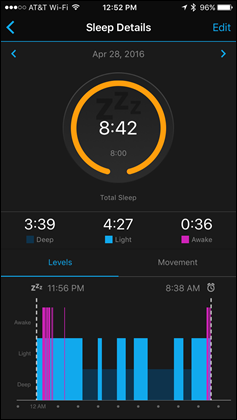
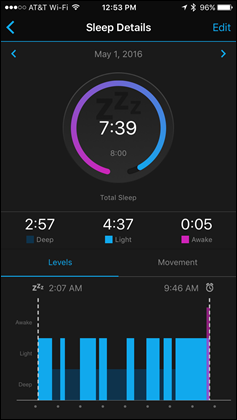
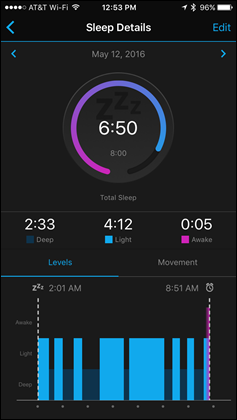
When it comes to accuracy of the sleep tracking, there’s two elements to it. First is whether it gets the falling asleep/wakeup times correct. For that, it seems pretty close to spot-on. For comparison, just a random day where I can show the Garmin data from the Vivoactive HR, as well as the Withings Aura and Emfit QS data:
To start, here’s the Garmin data. It shows me me falling asleep at 3:24AM, and waking up at 9:40AM. That’s about right, give or take a couple minutes.

Then, the Withings Aura and Emfit data (both sleep systems located below your mattress). The Withings Aura data shows nearly identical times. In this case, it shows me as awake for a while on both ends (correct).

Whereas the Emfit data seems to think I immediately fell asleep. The Emfit data is more detailed though (on many more levels than I’m showing here), appearing to roughly match what the Garmin is saying in terms of sleep states/classes (i.e. deep sleep). Whereas the Withings seems to split the difference on sleep states (but got timing more correct).

As you can see, things generally trend in the right ways, but there is still a bit of variation from device to device for sleep states. Given I have no way to independently confirm my sleep states, we’ll have to table that piece. Whereas for falling asleep/wake up times, that’s easy for me to confirm and generally speaking the unit gets that correct. For me with most of these products, I focus more on the sleep duration, rather than the exact sleep states.
Running:
I often start with running in my reviews, simply because it’s a good foundation point for other sports. In the case of most devices, many of the same concepts carry over to other sport modes. For example, data screens and configuration options are all very similar.
To begin an outside run with GPS (it supports both indoor and outdoor runs), we’ll press the lower right button, which shows off the available sport modes. Then we’ll tap ‘Run’. At this point it’ll start searching for both GPS signal, as well as a better lock on your HR via the optical HR sensor. The status of both is displayed at the top of the screen. GPS in a bar that will eventually turn green, and the HR icon will stay lit/solid once locked. Note below the HR icon isn’t yet illuminated, even though I have HR shown (61bpm).
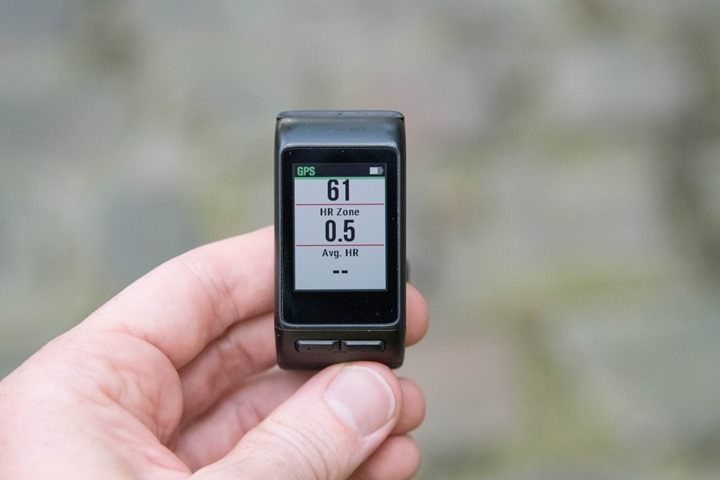
Then see how the HR icon is lit solid, which means it’s good to go. I have found this takes a bit longer than other Garmin devices (upwards of a minute sometimes).
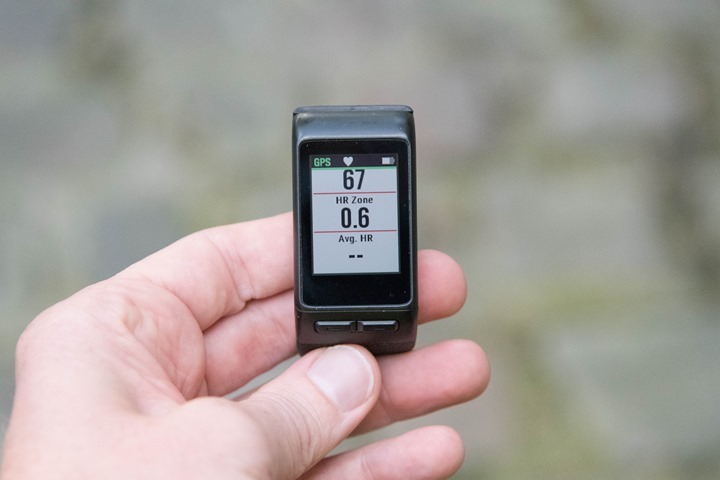
If you want to change any settings before or during your run, you’ll hold down the lower right button again (long hold), which opens up the settings menu. Initially you’ll be in the general settings menu, however you can tap ‘Run Settings’ to get to the sport-specific settings. This pattern follows for all sports. Within this area you can configure data screens, alerts, lap options (automatic lap or manual), auto pause, auto scroll, and GPS type. Plus visual aspects like the background and accent colors.
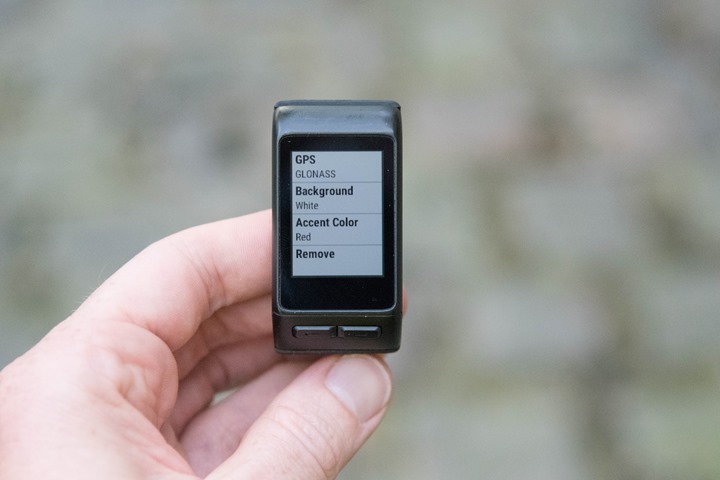
Most folks will be interested in the data screens. The Vivoactive HR gives you three customizable data screens.
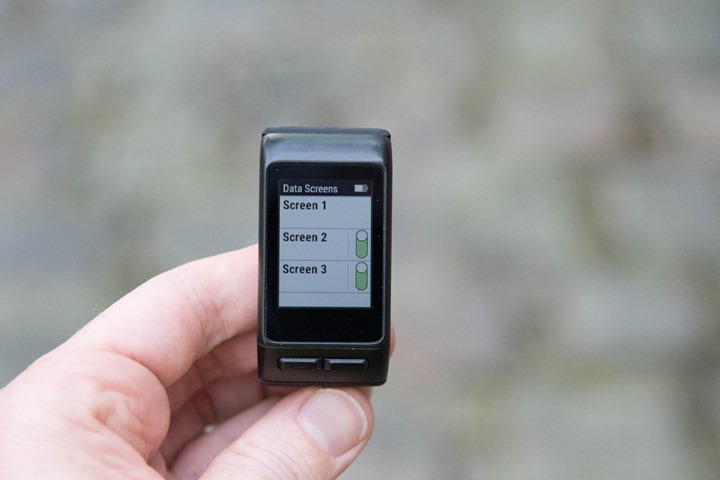
Each screen can be customized with either 2 or 3 data fields:
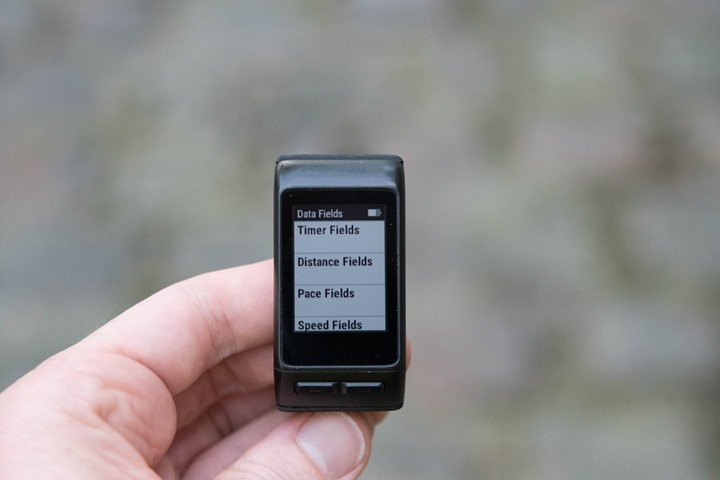
The available data fields as of this writing are:
Timer Fields: Timer, Lap Time, Last Lap Time, Average Lap Time, Elapsed Time
Distance Fields: Distance, Lap Distance, Last Lap Distance
Pace Fields: Pace, Average Pace, Lap Pace, Last Lap Pace
Speed Fields: Speed, Average Speed, Lap Speed, Last Lap Speed, Maximum Speed, 30s Avg Vertical Speed, Vertical Speed
Heart Rate Fields: Heart Rate, Average HR, HR Zone,Training Effect(removed), HR %Max, %HRR, Average HR % Max, Average %HRR, Lap HR, Lap %HRR, Lap HR %Max, Time in Zone
Cadence Fields: Cadence, Average Cadence, Lap Cadence, Last Lap Cadence
Temperature Fields: Temperature, 24-hour max, 24-hour Min
Elevation Fields: Elevation, Total Ascent, Total Descent
Other Fields: Calories, Heading, Laps, Sunrise, Sunset, Time of Day, Steps, Lap Steps
Phew! Lots of options.
As for satellite type, I tend to leave it on GLONASS. You’ll take about a 20% hit on GPS battery life, but it gives you more options for satellites, which may help sustain GPS coverage in tricky situations.
With all that ready to go, we’ll head out and run. Simply press the start button and it’ll begin recording.
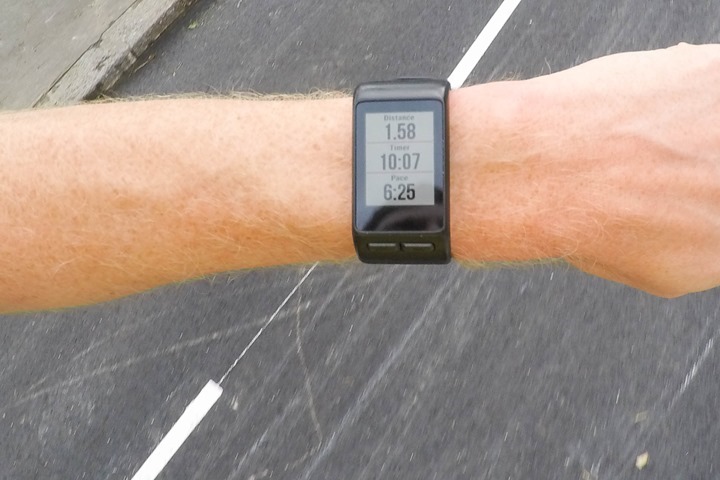
The unit gives you the option to use either autolap or manual lap. I prefer manual lap, which is enabled in the settings. Once you enable it, the lower left button becomes your lap button. To change screens while running, you’ll simply swipe the screen up/down on the touchscreen to rotate through the three screens.
The instant-pace is pretty darn stable on the unit. Here’s an example of it during a run as I keep a steady pace. I then stop and start, to show how fast it reacts:
Note that like virtually all Garmin wearables in the last few years, pace is shown in 5-second increments. This is to provide a bit more stability. All companies (Garmin/Polar/Suunto/Apple) have to smooth GPS data somewhere along the line. This seems to be the clearest way to do it. Note that if you’re trying to hit an interval pace at specific time (i.e. 6:22/mile), you can easily use Lap Pace instead (which shows down to the per-second digit). Plus, that’s a better way to pace sections anyway.
It’s worth pointing out that the Vivoactive HR doesn’t have a beeper of any sort (for audio alerts). Instead, it’s just vibration alerts. I didn’t really find this a problem though, either during running or otherwise. The vibration motor was strong enough for me.
Finally, to stop/pause your run, you’ll hit the lower right button again. This then allows you to save the workout.
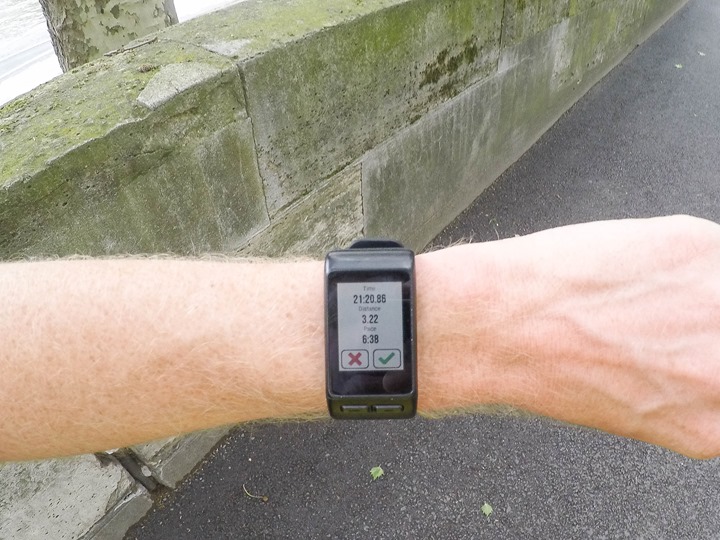
It’ll at this point give you any PR’s (personal records) that you may have triggered during the run.
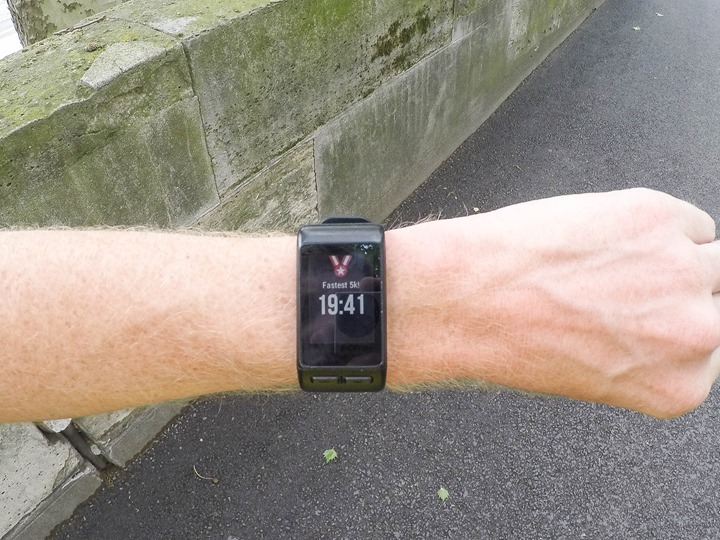
After which, your run is sync’d via your phone to Garmin Connect, where you can analyze it more deeply.
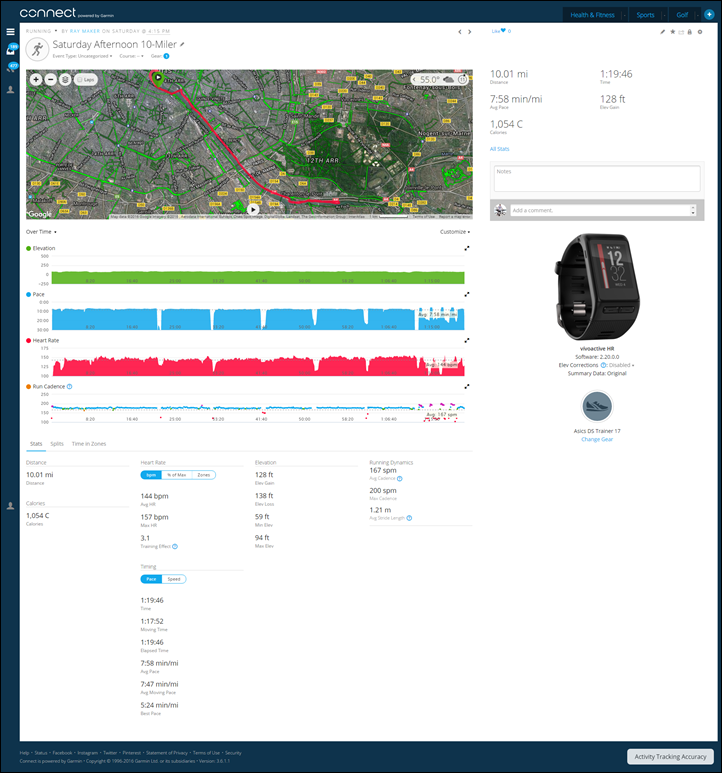
For your curiosity purposes, you can dig into the run above for example, using this link here.
Overall, for the vast majority of runners, the Vivoactive HR is a solid running watch. Note though that despite earlier statements from Garmin otherwise, the Vivoactive HR does NOT have 1-second recording rates (uses Smart Recording). This means it may appear that the unit is cutting corners on some maps, when in reality that distance is accounted for in the total distance, it just didn’t plot the points. Personally, I think this is kinda silly since all it does is increase support calls to Garmin and decrease consumer happiness. Plus, the file sizes even on 1-second recording rates are tiny. There’s no reason in 2016 to have Smart Recording any more (heck, there wasn’t a reason in 2010 either). Hopefully they’ll change that in future firmware updates. I wouldn’t let that be a purchasing blocker, but rather, just something to be aware of.
Cycling:
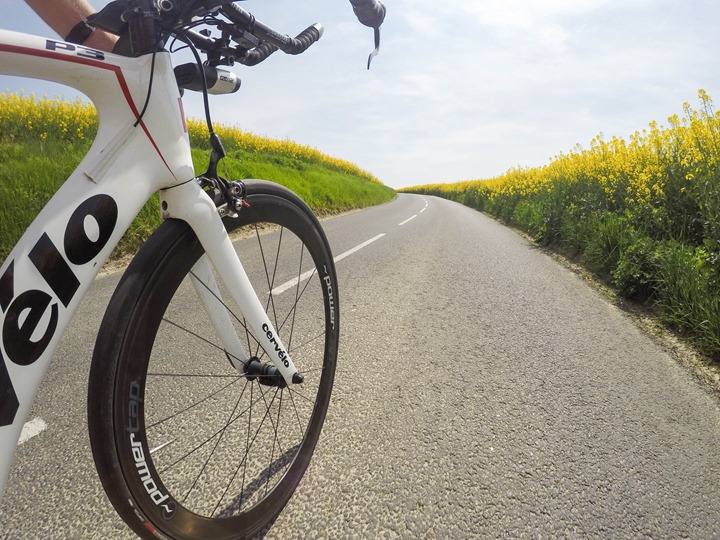
The Vivoactive HR can be used while cycling by enabling the bike mode. Within this mode it’ll collect optical HR data from your wrist, or, you can mount it to your bike using a simple bike mount (and then collect HR data via a chest strap). The unit can also pair to ANT+ Speed & Cadence sensors. It does not pair to cycling power meters or Bluetooth sensors.
I’ve used the unit on numerous bike rides, and as a watch it works mostly well. I’m the type of person though that somewhat prefers a dedicated bike computer. Something I can mount to the bike, versus having to rotate my wrist from wherever it is on the handlebars to see my watch. But to each their own.
Within the cycling mode (either GPS outside, or sensor-based indoors), you’ll get your standard speed & distance, as well as cadence if you have a cadence sensor. You can see this data on the watch in real-time by adding the cadence fields. It can support multiple paired sensors, so you can effectively save multiple bikes (it uses the ‘sensor pool’ concept). It does not have bike profiles.
Or, you can look at it afterwards on Garmin Connect, which will show any connected sensor data (see the ‘Bike Cadence’ section in orange):
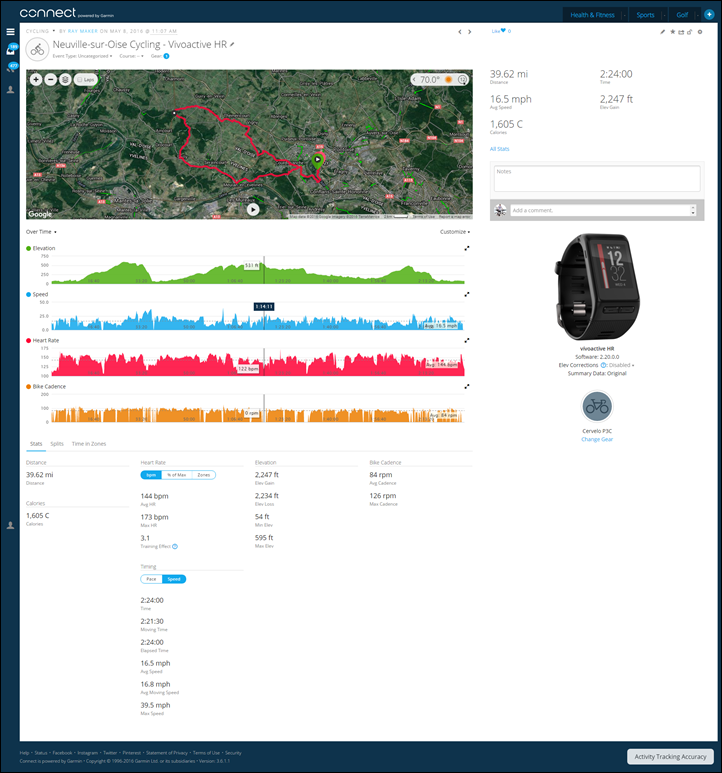
Now’s also a good time to talk about HR rebroadcasting. That feature allows you to leave the watch on your wrist, but broadcast the heart rate signal from the optical sensor to another device. This way if you have an ANT+ device (like a Garmin Edge), you can pickup the HR and display/record it. To enable this mode, you’ll hold down the settings button and go into the sensors menu and select the optical HR sensor and enable broadcasting.
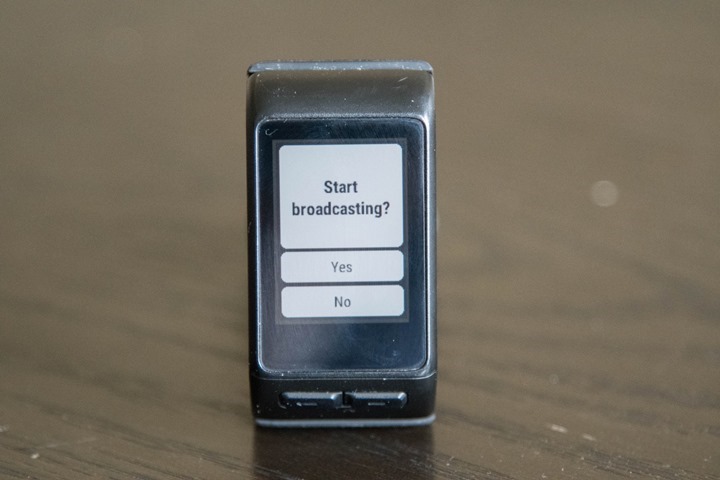
The only challenge here is that while in the broadcast mode, you can’t do anything else with the watch. You can start an activity though before you start broadcasting, in case you want to record it that way. But once you start broadcasting you can’t go back to your other screens. The activity will keep recording in the background though. All Garmin optical HR devices work this way.
(Update May 20th: In last night’s firmware it appears to have broken even that capability, now you can only enable broadcasting outside of an activity. Sigh.)
Because Garmin appears confused on why you’d want to do this, let me make this clear: The world doesn’t revolve around Garmin. The idea here being you can still record your workout on your Garmin device/platform, yet, you can also broadcast to another app/device/platform. Indoor training apps are precisely this reason: Zwift, TrainerRoad, PerfPro, etc… Cycling studios, etc… Why add such functionality only to cripple it?)
Now this sounds good in theory, and I’ve had good luck with the concept on other Garmin optical HR sensor enabled watches. But on the Vivoactive HR I’ve had a lot of issues with this. The broadcasting would end almost immediately after enabling it (a few seconds). Other users reported it ending after a few minutes. I brought the issue up to Garmin earlier in the week, and it sounds like it may have been fixed last night as part of a gigantic firmware update with many bug fixes in it. I’ll confirm back once I can validate that update during a workout (a longer duration).
Swimming:
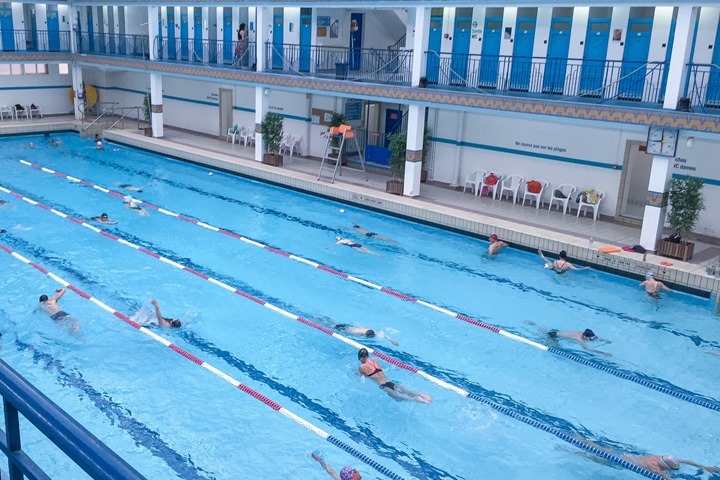
The Vivoactive HR supports the recording of swim data, though only pool swims and not openwater (lake/ocean/river/etc…) swims. The reason being that the Vivoactive HR lacks the algorithms required to be able to handle the satellite dropouts that occur each time your wrist dips below the surface during an openwater swim. Whereas in the pool, it uses internal accelerometers along with a known pool length to calculate distance. Note there are some 3rd party Connect IQ apps that can do openwater swims though (with varying levels of success).
I’ve used the VAHR on a number of pool swims now, and had virtually no issues with it. To begin you’ll need to setup the pool length. This is required for the unit to determine the laps you’ve swam.
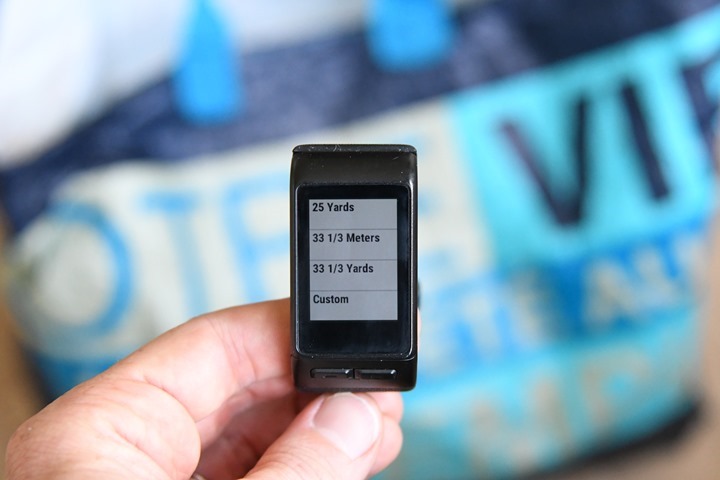
Next, you can customize a single data page for swimming. Once in the water, the touch screen is disabled, so you’ve only got one page to work with:
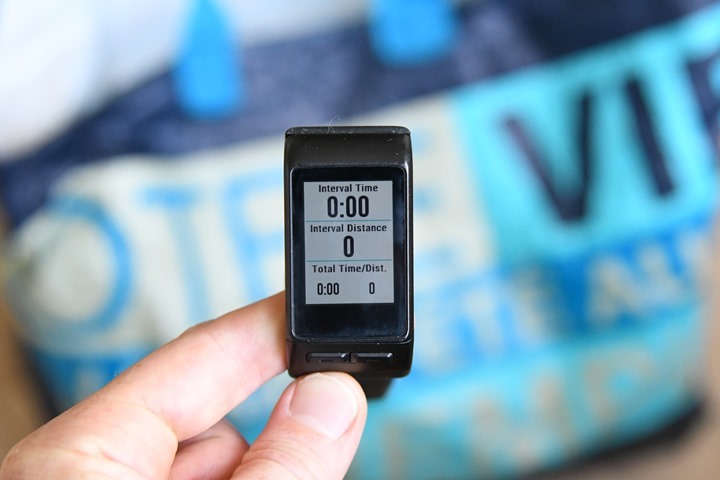
Once you press start, the unit will track distance and other metrics as you swim. You can do both flip and open (non-flip) turns and it won’t have any issues. In my pool I often switch back and forth between the two of them, as people like to stand around at the end of the lane lines and discuss the finer qualities of baguettes and cheese – thus blocking flip turns at one end.
In order to create sets (or intervals), you can use the left (lap) button. This will pause the watch and mark the end of a set. For example, on today’s swim I did an 800m warm-up. At the end of that, I hit the lower left button to pause it. When I did that it went ahead and inverted the screen, letting me know it was in paused mode.
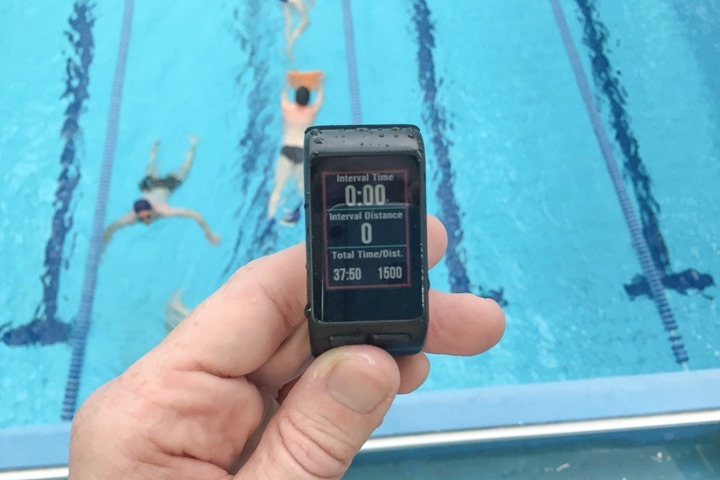
After my brief rest, I pressed the lap button again and it started a new set. This time keeping tabs within that set on the display fields I selected. Also, later on it’d show these sets within Garmin Connect:

Once you’re done, you can press the lower right button (stop) to stop the activity. A few seconds later the touch screen will re-activate and it’ll allow you to save your activity. Again – while swimming the touch screen is disabled.
Afterwards it’ll show you a brief overview of your swim activity. Though, it’s far easier to dive into the details on Garmin Connect.
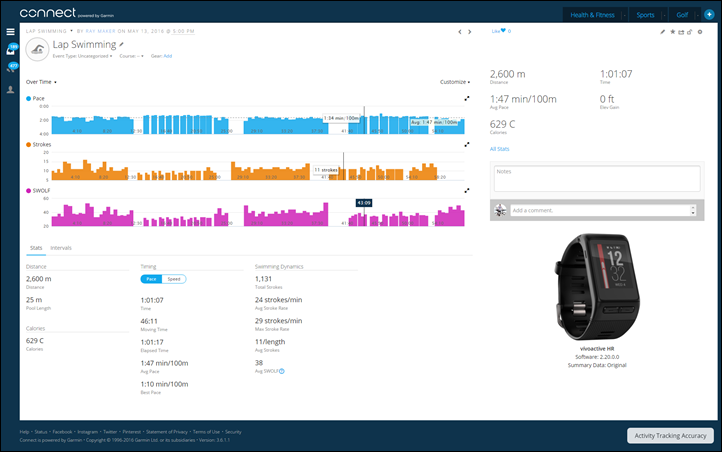
In my case, I only had 2-3 laps missing in total across all my swim sessions. In all of those cases they were easily explained by people stopping mid-lane in front of me, hosing up my ability to keep relatively consistent directional travel. Remember that accelerometers look for patterns, and stopping mid-way down a lane is a clear pattern that you ended that length of the pool.
Note that the Vivoactive HR does NOT connect to either the HRM-SWIM or HRM-TRI from a swimming data standpoint. It can use those straps for straight heart rate data while above water, but it cannot download HR data from those straps while in the water.
Additionally, the Vivoactive HR disables the optical HR sensor when you start a swim activity. Well, sorta. It actually does seem to poll occasionally for your 24×7 HR data. This is a bit of a change from the past when it didn’t do this. You can see that during my swim it did pick out some data points and plot those:

That said, what would happen if you left it totally enabled while swimming? And just how well would it work if you went openwater swimming in running GPS mode? Well, I figured I’d give both a whirl. So…off I went during a recent lake swim.
As you can see below, the answer on the GPS track is pretty crappy. The track looks like I was quite drunk. But this is a common looking track for a unit without openwater swim algorithms.

Here’s the same swim on the other wrist by a FR920XT – far cleaner and where I went:

As for the optical HR while swimming, it’s not ideal (hence likely why it’s not enabled). Below you can see how it compared to the HRM-TRI chest strap worn and then paired to the FR920XT. Sure, it may look like it kinda trends correctly, but if you look closer many of the peaks/valleys aren’t quite right.


My general recommendation is that if you want to record openwater swims that you place it in your swim cap and simply record it as an ‘Other’ activity and then manually re-categorize it on Garmin Connect later on (it takes two seconds to do). This time-tested and well used solution will give you the most accurate openwater tracks.
Other Sports:
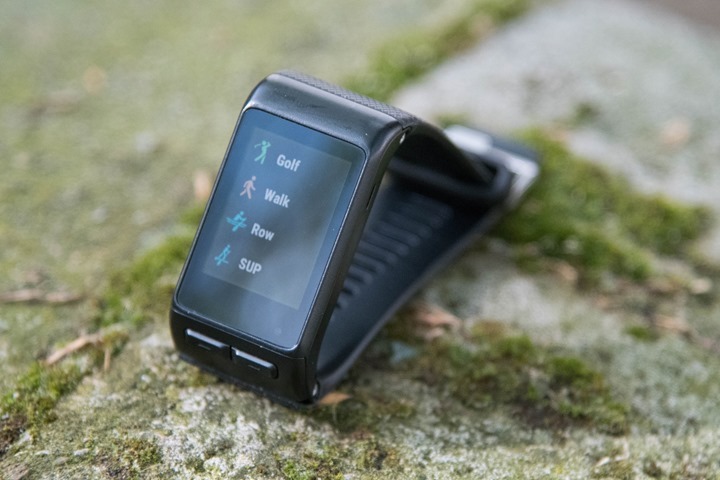
I just wanted to briefly touch on all the other sports that the Vivoactive HR includes within its repertoire. The full list of sport modes are:
– Run (GPS/Outdoor)
– Bike (GPS/Outdoor)
– Pool swim
– Golf
– Walk (GPS/Outdoor)
– Row (GPS/Outdoor)
– SUP (Stand Up Paddleboard)
– Ski/Snowboard
– XC Ski
– Run Indoor
– Bike Indoor
– Walk Indoor
– Row Indoor
Then there are these modes that are available to add:
– Strength
– Cardio
– Other
Don’t see a mode you want? Well, you can add apps, which are basically sports (actually, they really are sports technically speaking). For that you’d hit up the Connect IQ app store. Everything in said app store is free.

I want to briefly comment on a common question: Why does the Vivoactive HR have ski/snowboard mode, but not the new FR735XT, at twice the price?
For those not familiar, the ski/snowboard mode allows you to automatically track your ski runs. I’ve used in numerous ski trips, such as these semi-recent trips, on other Garmin devices. It works fantastically well. Probably one of the most dependable watch features they have. It pauses when you go up the lift, and then starts a new ‘run’ each time you start skiing/snowboarding. Pure awesomeness.
However, that feature requires a barometric altimeter. The Vivoactive HR has such a feature because it counts stairs for activity tracking (which requires the altimeter).
Now, as to why the FR735XT doesn’t have a barometric altimeter when devices 1/2 as much do? Eff if I know. Yeah, I agree, it’s stupid.
Optical HR Sensor Accuracy:
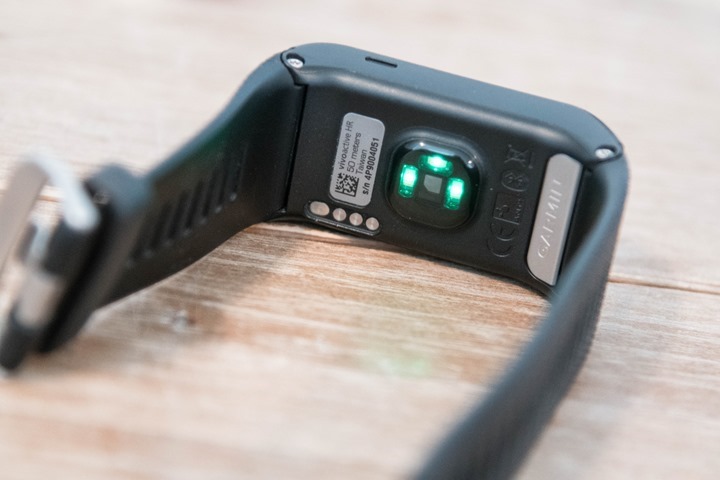
The Vivoactive HR includes Garmin’s Elevate optical HR sensor built into the bottom of it, which I used both in workouts as well as in 24×7 continual HR monitoring mode. Garmin introduced this sensor this past fall, after previously using optical HR sensors from Mio. While initially it was a bit rough in other products, subsequent firmware updates have significantly improved accuracy. These updates have largely been applied to existing Garmin products using the sensor (i.e. Vivosmart HR, Fenix3 HR, FR235, etc…).
With each subsequent new unit released I re-visit sensor accuracy. While it’s the same physical hardware, one can see the impact that firmware updates make. Additionally, each watch has a slightly different form factor (exterior design), which can impact accuracy in terms of external light getting into the sensor area (which degrades accuracy of optical HR sensors).
Before we move on to the test results, note that optical HR sensor accuracy is rather varied from individual to individual. Aspects such as skin color, hair density, and position can impact accuracy. Position and how the band is worn are *the most important* pieces. A unit with an optical HR sensor should be snug. It doesn’t need to leave marks, but you shouldn’t be able to slide a finger under the band (at least during workouts). You can wear it a tiny bit looser the rest of the day.
Ok, so in my testing I simply use the watch throughout my normal workouts. Those workouts include a wide variety of intensities and conditions, making them great for accuracy testing. I’ve got long/steady runs, hard interval workouts on both bike and running, as well as tempo runs. Night and day runs, rain and sun runs.
For each test I’m wearing additional devices, usually 3-4, which capture data from other sensors. Typically I’d wear a chest strap (usually the HRM-TRI), as well as another optical HR sensor made by Scosche. I generally consider that sensor to be the most accurate optical HR sensor for fitness/workouts today.
We’ll begin with a tempo run of sorts from a couple days ago (May 17th). It immediately followed a bike, so I was already a bit warmed up. I’m starting with this run, because I think it best represents what I see with the sensor. Specifically that if it stumbles anywhere, it’s almost always in the first couple minutes. Once it gets past that point, it’s usually fine. You can see this below.

Here, I’ll zoom in a bit. You can see the Vivoactive HR is off by up to 25bpm for a couple minutes, compared to everyone else.

But, as shown above, after that point it settles in nicely for the rest of the run.
Let’s then dig into an interval run, which has lots of stop/go sections, thus putting a strain on the optical HR sensors in terms of keeping track of things. We’ll start with an easier interval run, longer sets.

You can see that it handles the work portions without fail, it nails that. But it does struggle a little bit on the recovery section, especially in the first interval where it totally misses the recovery. But again, towards the end in those 4 spikes (30-second hard intervals), it actually tracks the work portion very closely. It’s just the recovery that it seems to miss a bit.
But on this interval run below (different than above), it handles pretty well. And has no issues during the warm-up. You see some slight variance from the Scosche early on, I suspect that’s because I just discovered one of the three Scosche LED’s died (2 years old, multiple washing machine trips). Still, after that, everyone is mostly happy.

And there are many cases where the HR tracks just fine during a run. This simple 5K run is a good example of that:

As is this tempo run, where only briefly towards the end it seemed to trip up (I believe it matched my cadence briefly down a short downhill section):

Moving to cycling, we’ll start with an indoor trainer. This is a longer interval workout. In general, it’s good, but there are these random points where it just gets lost for a short bit. I’ve added a 15-second smoothing to this graph (May 10th) to make it easier to spot these oddities:

Going outdoors, here’s a 2hr 30min ride (May 8th). The first half of this ride (up until that weird gap) is actually three straps: Scosche, HRM-TRI, Vivoactive HR optical. However, the Scosche battery died at the 1hr 15min marker (I forgot to charge it), so I switched the Edge 520 over to the HRM-TRI. But the text shows otherwise. In any case, up until that point, the three units agreed quite nicely.

Afterwards, which is roughly when I started pushing a bit more, is when I started seeing more variation. Lots of variation. The above graph is smoothed at 30-seconds due to the length, to make it easier to see variances. There’s a lot of the second half of the ride that just doesn’t pan out well for the Vivoactive HR.
Moving to another ride, this one has initial city sections at both start/beginning (so rougher roads), and then I do laps/loops around a park in the middle. So you see some (barely) consistency in the middle. But by and large it’s a total mess.

Even indoors, in this simple trainer ride yesterday (May 19th), both of Garmin’s Elevate optical HR sensors (one on each wrist) seemed totally confused for the first five minutes. Then they locked on and were perfect after that. Yet two days prior on a virtually identical workout, both units handled mostly well during that time period.

Note that all of my workouts while using the device are available for you to analyze yourself. They’re in the below table. You can see the other comparison devices for each one. This same table is also in the GPS section, the links are same. The dates for each of the graphs above are in the upper right corner.
Vivoactive HR Data Sets
25-AprCyclingGPS/HRAnalyze26-AprSwimmingJust poolN/A28-AprRunningGPS/HRAnalyze1-MayRunningGPS/HRAnalyze2-MayRunningGPS/HRAnalyze3-MayCyclingGPS/HRAnalyze4-MaySwimmingJust poolN/A6-MayTrainerHRAnalyze6-MayRunningGPS/HRAnalyze7-MaySwimmingJust poolN/A8-MayCyclingGPS/HRAnalyze8-MayRunningGPS/HRAnalyze9-MaySwimmingJust poolN/A10-MayTrainerHRAnalyze10-MayRunningGPS/HRAnalyze11-MaySwimmingJust poolN/A12-MayTrainerHRAnalyze12-MayRunningGPS/HRAnalyze13-MayPoolJust poolN/A14-MayRunningGPS/HRAnalyze15-MaySwimmingJust poolN/A17-MayTrainerHRAnalyze17-MayRunningGPS/HRAnalyze18-MaySwimmingJust poolN/A19-MayTrainerHRAnalyze19-MayRunningGPS/HRAnalyze
Before I continue to the resting HR section, do remember that I covered HR rebroadcasting within the cycling section (for lack of anywhere else to put it). In that mode it simply broadcasts your HR as if in sport mode. So from an accuracy standpoint nothing is different there (despite my connection issues).
Finally, we’ve got 24×7 HR data. In general, I find the actual tracking of my heart rate to be accurate. Which is to say that if I look down at the watch at any point in time during the day, the HR is correct. For example, as I sit here typing this it’s shifting between 48-55bpm depending on how fast my fingers are typing. All’s good there.
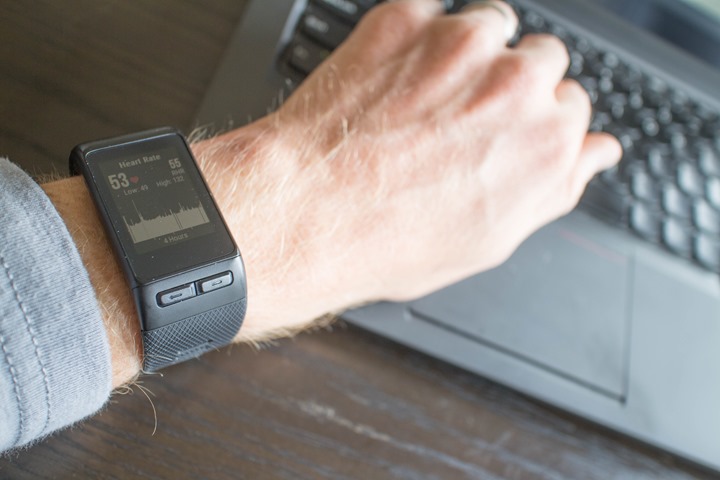
Where things get a bit messy though is what happens when I fall asleep, as well as how it computes my RHR. First, let’s start with RHR (Resting HR). This value is generally agreed upon as being the lowest HR value you see. Where there is some disagreement among organizations is whether to count sleep in ‘resting’. That’s fine though, that’s a philosophical debate. We’ll set that aside for the moment.
What’s not fine is the above (click to zoom). In this case, as I type this paragraph it shows me at a HR of 53bpm. And the lowest HR value it shows for the four hour time block is 49bpm. Yet as you see above – somehow my RHR value is 55bpm. Huh?
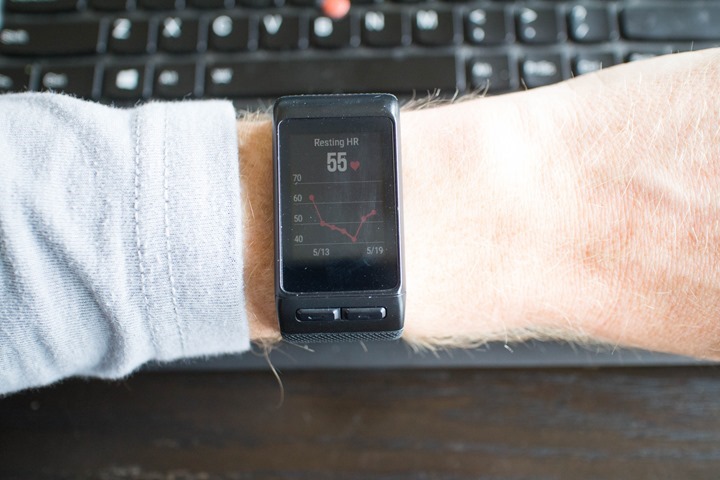
Next there’s the RHR tracking page. This shows my RHR trends for the past few days. You can click on a given day to get more details about it.
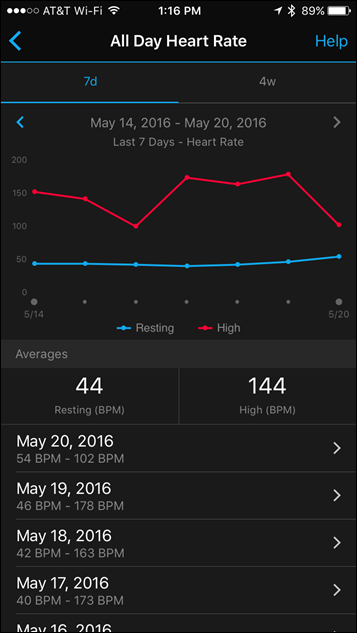
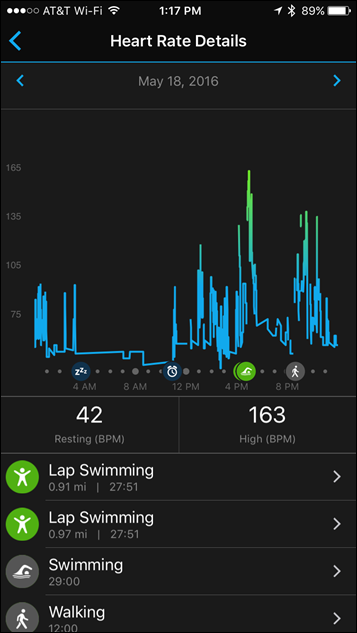
So what about sleep that I mentioned? Well, there’s two issues here. First is that once I fall asleep, Garmin fails to keep checking in on my HR. For example, the below. There are huge multi-hour gaps there. It’d be one thing if it just checked in a few times per hour (still low btw), but 2 hour+ gaps?

Garmin has done some work in other Elevate based watches to increase polling during the movement (daytime), and that’s much better than before. But the failure to poll correctly at night is still an issue. I’m not sure why it’s so difficult to simply have the optical HR sensor check in every 15 minutes even if there wasn’t enough movement to warrant a check otherwise. Fitbit, Basis, and others are more than capable of polling every second, so surely Garmin can check in four times an hour (Just 4 seconds of 3,600).
Oh, for lack of anywhere else to talk about battery, I’m going to plop it here. After all, the optical HR sensor is (on all optical devices) one of the biggest battery drains there is. So how well does the Vivoactive HR’s battery hold up? Well it’s a bit tricky to say, because I’ve got about 1hr of GPS runs/rides per day mixed in there (much longer on weekends), so that impacts things a bit in terms of number of days it lasts. But I’d peg it at about 4-5 days between charges, inclusive of the GPS data for outdoor activities.
GPS & Altimeter Accuracy:
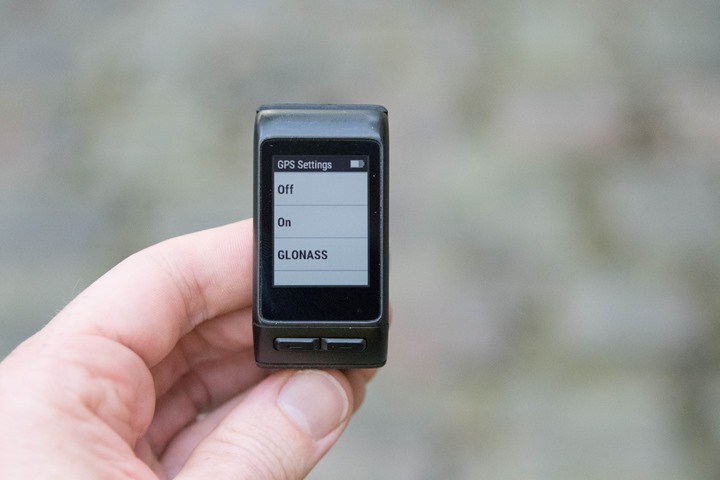
Next up, GPS accuracy. For my tests, I prefer to simply ride and run all over creation. Meaning that I’m out running the various and unique routes, it’s just that I’m carrying multiple GPS devices at the same time to measure that specific run. I think it’s super critical that you’re comparing data from the same exact run, as conditions can vary day to day. I also think it’s valuable that you run all sorts of different conditions, thus running the same route over and over isn’t as valuable to me as running/riding everywhere. Note that since I live in the city, most of my running/riding tends to start there. Though, it then usually heads out into the countryside or large parks. Thus I get a pretty wide variety of environmental conditions.
Let’s start with a 10-mile run I did on Saturday (May 14th). For this, it was basically a simple out and back. At the super-high level, you don’t notice any unit being an obvious outlier:

And the totals at the end seem to reflect that:

But still, let’s see where (if anywhere), things went wrong. If I zoom into the end (lower right corner), at the turnaround, you see a bit of disagreement. That area seems to account for virtually all of the differences between these units. Some of that was caused by a large bridge/overpass and going below that. Certain units did better than other units, though the Vivoactive HR actually handled this section quite well.

Another area that tends to cause watches issues on my runs, is this turn on/off this specific bridge. I don’t know why, but it repeatedly trips up units. But this time, all units made it on/off the bridge without too much issue. One could poke a bit at the Ambit3 Vertical here, but we’re only talking a couple meters variance in one direction.

Switching to a totally different run (May 12th), I wanted to show how well it tracked across a bridge. All three units agreed, and even more interesting, all three units even got the correct side of the bridge nailed:

On the flip side, a few hundred meters away, all three units struggled a tiny bit as I went down a road in between two 5-8 story buildings. This is a bit of a GPS canyon, and many units struggle here. None were horribly off, but certainly a bit into the buildings. Oh – and a reminder. You can click to zoom in any on any of these maps using the table below (hence why I’m mentioning the date).

While I could keep on showing sections the Vivoactive HR did well (or minor areas it fumbled briefly alongside others), I found that across the board it did quite well in GPS accuracy. But again, you can dig into any of the GPS activities below and poke around yourself.
Vivoactive HR Data Sets
25-AprCyclingGPS/HRAnalyze26-AprSwimmingJust poolN/A28-AprRunningGPS/HRAnalyze1-MayRunningGPS/HRAnalyze2-MayRunningGPS/HRAnalyze3-MayCyclingGPS/HRAnalyze4-MaySwimmingJust poolN/A6-MayTrainerHRAnalyze6-MayRunningGPS/HRAnalyze7-MaySwimmingJust poolN/A8-MayCyclingGPS/HRAnalyze8-MayRunningGPS/HRAnalyze9-MaySwimmingJust poolN/A10-MayTrainerHRAnalyze10-MayRunningGPS/HRAnalyze11-MaySwimmingJust poolN/A12-MayTrainerHRAnalyze12-MayRunningGPS/HRAnalyze13-MayPoolJust poolN/A14-MayRunningGPS/HRAnalyze15-MaySwimmingJust poolN/A17-MayTrainerHRAnalyze17-MayRunningGPS/HRAnalyze18-MaySwimmingJust poolN/A19-MayTrainerHRAnalyze19-MayRunningGPS/HRAnalyze
Oh, finally, what about barometric altimeter data? Well, that data is in the analysis tables too. But just in case you wanted an overview of what it shows – here’s a look at a few examples. First, a run. In this case you can see the Vivoactive HR tracks along quite nicely with the also barometric based FR920XT. Meanwhile, the GPS-altimeter based FR630 is all over the place.

Here’s another example, this one from a ride. You can see it compared against the Edge 520 (also barometric). Both units mirror each other, though with a slight offset. I don’t typically bother to change/set altitudes manually unless I’m in the mountains and find an altitude marker somewhere. In this case they vary about 5m offset from each other until about half-way through the ride. It’s at that point that it started dumping out (storm coming in). It’s then we see the Vivoactive HR drop a bit in altitude, though still match the pattern here. On the flip-side, the Edge 520 rises slightly. Note that in the middle section those are loops around a park, so the altitude would be identical each time.

Here’s another example of a ride to that same park. In this case, the Edge 520 & Vivoactive HR start off quite far apart, but over time the Vivoactive HR decides the Edge 520 is right, and slowly converges on it to identically match by time I finish the loops and head home. Meanwhile, the FR630 is off beating to its own drum.

And finally, one last ride example. This one is actually really clean – shows nice agreement. I suspect the reason you see such good agreement throughout the entire ride, is that this was after using the watch outdoors at that location (with GPS), so the unit had time for the barometer to settle.

Note that you can calibrate the altimeter on the Vivoactive HR, so that would likely reduce any of the slight shifting that I’ve seen. It just appears that the Edge 520’s automatic calibration algorithms are a bit superior to that of the Vivoactive HR.
To access the altimeter calibration menu on the Vivoactive HR, you’ll hold down the lower right button, then Settings > Sensors > Altimeter > Calibrate > [Enter your altitude]. Pretty simple really. There aren’t any other altimeter options beyond that though (unlike some more advanced watches like the Fenix3 series). Still, for most people this setting along with the defaults will probably give you what you want in terms of ascent/descent values.
Smartphone Integration:
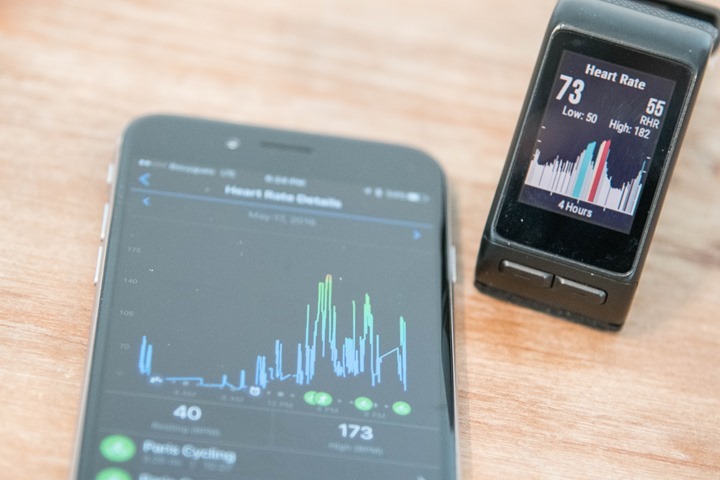
Like all Garmin wearables these days (heck, any wearable these days), the Vivoactive HR connects to your smartphone to provide additional functionality. At the basic side of things it’ll sync frequently using Bluetooth Smart to update Garmin Connect mobile, which is the application that allows you to view your workouts, steps, and other daily health goodness (such as data from the Garmin WiFi scale).
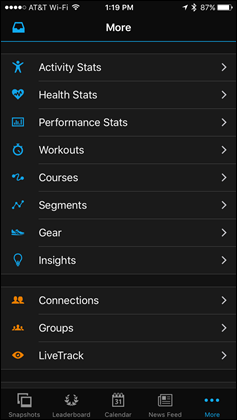
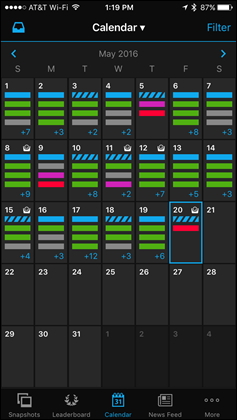
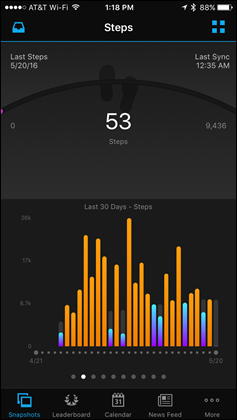
However, more than that, the phone can push notifications to your watch. These notifications are configured using your phone’s notification control panel. The Garmin Connect Mobile app is available for iOS, Android, and Windows Phone.
The notifications show up concurrently (basically instantly) with your phone’s notifications. So as you get one on the phone’s screen, it’ll buzz your watch. You can then clear the notification on the watch, which also clears it from your phone’s home screen.
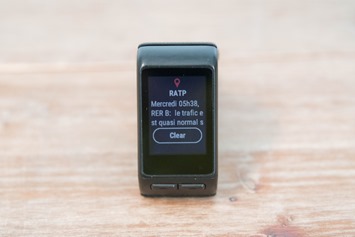
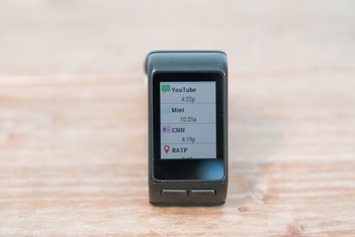
Next, the watch uses that Bluetooth Smart connection to get data for various widgets. You can download all assortment of widgets/apps from the Garmin Connect IQ store. But out of the box you’ll have a weather widget, a calendar widget, along with ones for controlling music on your phone.
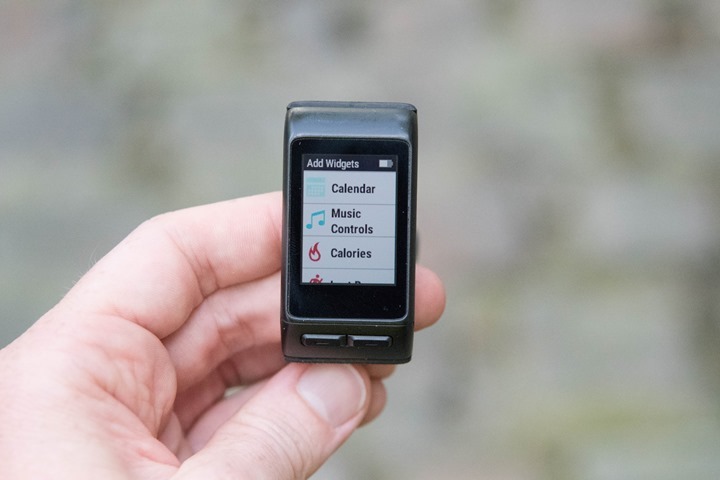
All of these work fairly well. Note that these data/information service focused widgets generally require connectivity to your phone to see data. In other words, the calendar widget won’t work if your phone isn’t in range. Nor will it work if the Garmin Connect mobile app is closed (background is fine).
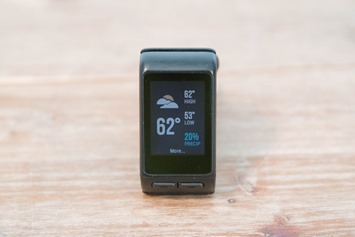
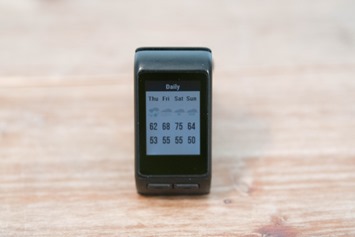
But, general notifications will work just fine if the Garmin Connect mobile app is closed. That’s because that connection happens directly between the phone’s operating system and your watch.
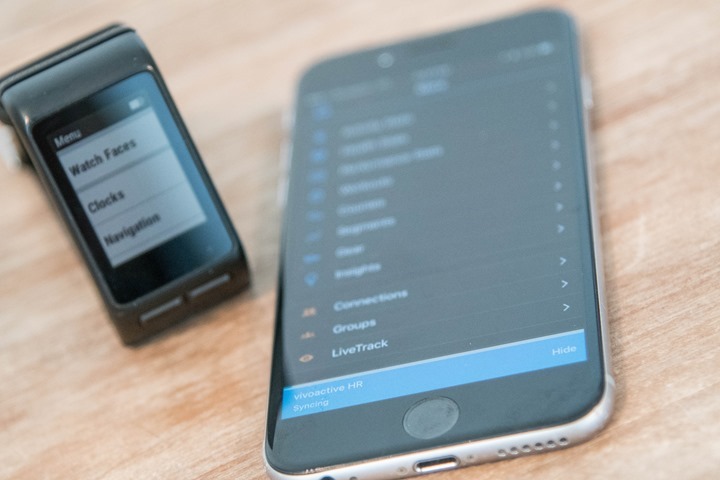
The data sync of workouts typically happens in the background without you even realizing. Generally speaking an hour-long GPS based workout may take 30-60 seconds to sync. That depends on how much sensor data there is, or how much GPS movement there was (since it uses Smart Recording). For steps, that’s constantly syncing throughout the day. There’s very little impact to battery for either your phone or the device. On the device side it happens via the low-power Bluetooth Smart protocol/connection.
Product Comparison Charts:
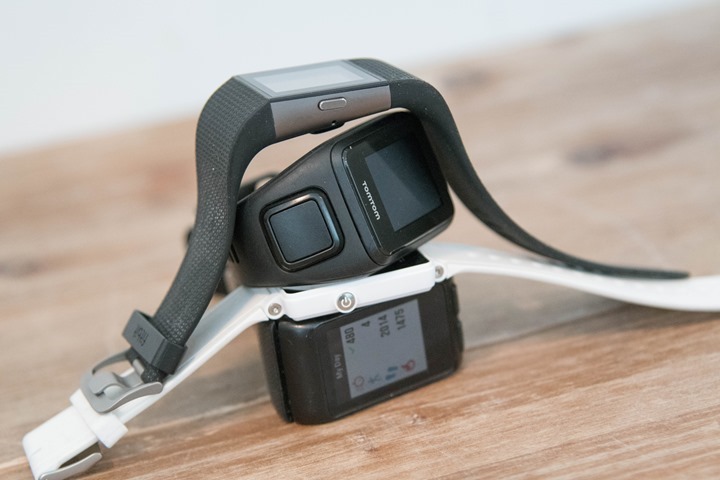
I’ve added the Vivoactive HR into the product comparison tool, which allows you to compare the Vivoactive HR against any other watch I’ve reviewed. For the sake of comparison, I’ve framed it up against a few competitors that I think most folks will be comparing against. Additionally, I’ve decided to add a few quick thoughts ahead of that.
Vivoactive HR vs Fitbit Surge: On a pure feature basis, there’s really no competition here. While both units are priced the same, the Vivoactive HR has approximately 3,283 more features than the Fitbit Surge. Ok, maybe just like 80 extra features. But, none of that really matters if you’re focused on counting steps and all your friends are on the Fitbit platform. Or if you use other Fitbit wearables/devices. From an accuracy standpoint, the Garmin optical HR sensor has improved enough to say that it’s better than the Fitbit optical HR sensor. And, the Vivoactive HR does more in terms of modes (swim, golf, sensor support, etc…). The Fitbit Surge is about 18 months old, so its starting to show its age in this fast paced market.
Vivoactive HR vs Garmin FR230/FR235: This is actually easier than you think. While the FR230 & Vivoactive HR are priced nearly the same, the FR230 lacks an optical HR sensor. If you want that, it costs another $80 (FR235). But why is it more? Well, the FR230/235 are running watches. They’re not all-rounders like the Vivoactive HR. So they’ve got more advanced running features. Things like VO2Max estimation, structured workouts, interval modes, and so on. For many people, those features won’t matter. So in that way, the Vivoactive HR is probably the best all around watch for runners at a cheaper price point than the equally optical-equipped FR235.
Vivoactive HR vs TomTom Spark: This is a pretty solid competitive comparison. Both units support running, cycling, and pool swimming (neither support openwater swimming). The TomTom Spark has some additional running focused modes around intervals. But more importantly, the TomTom Spark has music storage. So you can connect Bluetooth headphones to it. From an optical HR sensor accuracy range, both are in the same ballpark. Garmin has more sport modes (and customization), and generally updates the firmware more often. But again, the TomTom has music. So if that’s a major factor for you, it’s definitely a unit to consider
Vivoactive HR vs Polar M400: The Polar M400 is getting a bit long in the tooth, almost 2 years now (Aug 2014). Though, it’s received some modest firmware updates over the years to keep it in the game as a reasonably good low to mid range running watch. It doesn’t have an optical HR sensor, nor all the partnerships that Garmin or Fitbit has. But it’s a better running watch than the Fitbit Surge is in terms of features and data. It’s just going to require a separate HR strap. As for comparing it to the Vivoactive HR, that’s tougher. It’s roughly $80 less than the Garmin, so that may be a factor for some.
Vivoactive HR vs Apple Watch: This is a bit of an awkward comparison, but I know I’ll get asked it 98 times…in the first day alone. The Apple Watch isn’t a GPS running watch, it requires your phone to get GPS data. Otherwise it uses an accelerometer, which isn’t super-accurate based on my testing. The Vivoactive HR gets a number of days of battery life, whereas the Apple Watch gets 24-36 hours. On the flip side, the Apple Watch has a gazillion apps for it that you know the names of (Instagram, United Airlines, etc…). The Vivoactive HR has a crap-ton too, but 99.99% of them you’ll never have heard of. But neither points really matter: If you want a fitness watch, go to a fitness company. If you want a day to day/office watch, get the Apple Watch.
As for the comparison tables, here ya go:
Copyright DC Rainmaker – Updated May 19th, 2017 @ 6:13 pmNew Window
Price$249$249$329$149-$199 (Features Vary)
Product Announcement DateFeb 19th, 2016Oct 27th, 2014Oct 21st, 2015Sept 3rd, 2015
Actual Availability/Shipping DateQ2 2016Dec 10th, 2014November 2015October 1st, 2015
GPS Recording FunctionalityYesYesYesYes
Data TransferUSB, BLUETOOTH SMARTBluetooth SmartUSB, Bluetooth SmartUSB/Bluetooth Smart
Waterproofing50 metersATM5 (~50m), but no swimming50 Meters50m
Battery Life (GPS)13 hours GPS on10 hours GPS on (5-7 days in time/step mode)Up to 16 hoursUp to 11 hours (varies)
Recording IntervalSmart Recording1-second1-second & Smart1s
Satellite Pre-Loading via ComputerYesNoYes3 days
Quick Satellite ReceptionYesSo-soGreatYes
AlertsVibrate/VisualYesVIBRATE/SOUND/VISUALVIBRATE/SOUND/VISUAL
Backlight GreatnessGoodGoodGoodGreat
Ability to download custom apps to unit/deviceYesNoYesNo
Acts as daily activity monitor (steps, etc…)YesYesYesYes
Can control phone musicYesNoYesNo
Has music storage and playbackNoNoNoYes
Bluetooth Legacy (pre-4.0) to PhoneNoNoNoNo
Bluetooth Smart (4.0+) to Phone UploadingYesYesYesYes
Phone Notifications to unit (i.e. texts/calls/etc…)YesText and Call notifications onlyYesYes
Live Tracking (streaming location to website)YesNoYesNo
Group trackingNoNoNo
Emergency/SOS Message Notification (from watch to contacts)NoNoNoNo
Built-in cellular chip (no phone required)NoNoNoNo
Designed for cyclingYesYesYesYes
Power Meter CapableWith some Connect IQ apps (but cannot record data)N/AWITH SOME CONNECT IQ APPS (BUT CANNOT RECORD DATA)No
Speed/Cadence Sensor CapableYesN/AYesYes
Strava segments live on deviceNoNoNoNo
Crash detectionNoNoNo
Designed for runningYesYesYesYes
Footpod Capable (For treadmills)YES (Also has INTERNAL ACCELEROMETER)NO, HAS INTERNAL ACCELEROMETERYES (Also has INTERNAL ACCELEROMETER)No (Can use internal accelerometer)
Running Dynamics (vertical oscillation, ground contact time, etc…)NoNoNoNo
VO2Max EstimationNoNoYesNo
Race PredictorNoNoYesNo
Recovery AdvisorNoNoYesNo
Run/Walk ModeYesNoYesNo
Designed for swimmingYesNoNo (protected though just fine)Yes
Openwater swimming modeNoN/AN/ANo
Lap/Indoor Distance TrackingYesN/AN/AYes
Record HR underwaterNoN/AN/ANO (NOT ENABLED IN SWIM MODE)
Openwater Metrics (Stroke/etc.)NoN/AN/ANo
Indoor Metrics (Stroke/etc.)YesN/AN/AYes
Indoor Drill ModeNoN/AN/ANo
Indoor auto-pause featureNoN/AN/ANo
Change pool sizeYesN/AN/AYes
Indoor Min/Max Pool Lengths17M/18Y TO 150Y/MN/AN/A15m-50m
Ability to customize data fieldsYesN/AN/AYes
Can change yards to metersYesN/AN/AYes
Captures per length data – indoorsYesN/AN/AYes
Indoor AlertsYesN/AN/AGoals only
Designed for triathlonNoNoNoSorta
Multisport modeNoNoNoNo
Create/Follow custom workoutsNoNoYesNo
On-unit interval FeatureNoNoYesYes
Training Calendar FunctionalityNoNoYesNo
Auto Start/StopYesNoYesNo
Virtual Partner FeatureNoNoNoYes
Virtual Racer FeatureNoNoNoYes
Records PR’s – Personal Records (diff than history)YesNoYesNo
Day to day watch abilityYesYesYesYes
Hunting/Fishing/Ocean DataNoNoNoNo
Tidal Tables (Tide Information)NoNoNoNo
Jumpmaster mode (Parachuting)NoNoNoNo
GeocachingNoNoNonO
Weather Display (live data)YesNoYEsNo
Follow GPS Track (Courses/Waypoints)NoNoNoNo
Markers/Waypoint DirectionYes (to pre-saved spots)NoNoNo
Routable/Visual Maps (like car GPS)NoNoNoNo
Back to startYesNoYesNo
Impromptu Round Trip Route CreationNoNoNoNo
Download courses/routes from phone to unitNoNoNoNo
Altimeter TypeBarometricBarometricGPSGPS
Compass TypeMagneticN/AN/ANone
Optical Heart Rate Sensor internallyYesYESYEsYes
Heart Rate Strap CompatibleYes – CONTAINS OPTICAL HR SENSORContains optical HR SENSORYesYes
ANT+ Heart Rate Strap CapableYesNoYesNo
ANT+ Speed/Cadence CapableYesNoYesNo
ANT+ Footpod CapableYesNoYesNo
ANT+ Power Meter CapableNoNoNoNo
ANT+ Weight Scale CapableNoNoNoNo
ANT+ Fitness Equipment (Gym)NoNoNONo
ANT+ Lighting ControlYesNoNONo
ANT+ Bike Radar IntegrationYesNoNONo
ANT+ Trainer Control (FE-C)NoNoNONo
ANT+ Remote ControlYES FOR GARMIN VIRBNoYES FOR GARMIN VIRBNo
ANT+ eBike CompatibilityNoNoNONo
ANT+ Muscle Oxygen (i.e. Moxy/BSX)NoNoYesNo
ANT+ Gear Shifting (i.e. SRAM ETAP)NoNoNoNo
Shimano Di2 ShiftingNoNoNONo
Bluetooth Smart HR Strap CapableNoNoNOYes
Bluetooth Smart Speed/Cadence CapablenONoNOYes
Bluetooth Smart Footpod CapableNoNoNONo, has internal accelerometer
Bluetooth Smart Power Meter CapableNoNoNONo
Temp Recording (internal sensor)Sorta (Available only in Skiing/SUP)NoNONo
Temp Recording (external sensor)YesNoYES (TEMPE)No
Compatible with Firstbeat HR toolsNoNoTBDNo
PC ApplicationGarmin Express – Windows/MacWindows/MacGarmin ExpressMySports Connect
Web ApplicationGarmin ConnectYesGarmin ConnectTomTom MySports
Phone AppiOS/Android/Windows PhoneiOS/Android/Windows PhoneiOS/Android/Windows PhoneiOS/Android
Ability to Export SettingsNoNoNoNo
Amazon LinkLinkLinkLinkLink
Clever Training – Save a bunch with Clever Training VIP programLinkLinkLinkLink
Clever Training – Save a bunch with Clever Training VIP programLinkLink
Review LinkLinkLinkLinkLink
Again remember that you can mix and match and make your own comparison tables here using the product comparison tool.
Summary:
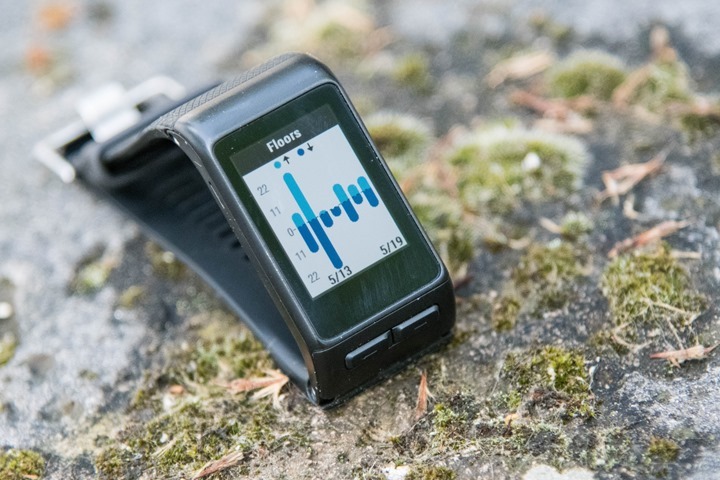
Overall the Vivoactive HR is a pretty solid multi-tasking unit. It seems to accurately track GPS on cycling and running, and I haven’t had any issues while in the pool either. It’s not the most advanced watch Garmin makes, but it’s also not the most basic. It sits nicely in the middle of the road, and offers what 90-95% of runners would want in a running watch. Or, what the majority of people would want in a day to day fitness smartwatch.
As noted throughout the post, I did see a handful of bugs. Both with the optical HR sensor, as well as just other random things. Some of the non-HR sensor pieces appear to have been addressed in a firmware update that was released yesterday afternoon (May 19th), such as areas around move notifications. But areas such as resting HR number inconsistencies Garmin says is slated for a future firmware update.
Since I already outlined how it compares to various competitive units in the previous section, I’d simply summarize that it’s an incredibly competitive watch in terms of features vs price. While it’s certainly not as thin as the previous Vivoactive, I think the market is clearly going towards optical HR sensors being the norm. So it makes sense for them to take the Vivoactive line in this direction, despite making the unit a bit chunkier.
With that – thanks for reading!
Found this review useful? Wanna support the site? Here’s how:

Hopefully you found this review useful. At the end of the day, I’m an athlete just like you looking for the most detail possible on a new purchase – so my review is written from the standpoint of how I used the device. The reviews generally take a lot of hours to put together, so it’s a fair bit of work (and labor of love). As you probably noticed by looking below, I also take time to answer all the questions posted in the comments – and there’s quite a bit of detail in there as well.
I’ve partnered with Clever Training to offer all DC Rainmaker readers exclusive benefits on all products purchased. By joining the Clever Training VIP Program, you will earn 10% points on this item and 10% off (instantly) on thousands of other fitness products and accessories. Points can be used on your very next purchase at Clever Training for anything site-wide. You can read more about the details here. By joining, you not only support the site (and all the work I do here) – but you also get to enjoy the significant partnership benefits that are just for DC Rainmaker readers. And, since this item is more than $75, you get free 3-day (or less) US shipping as well.
Garmin Vivoactive HR (select dropdown for sizing)
Additionally, you can also use Amazon to purchase the unit (though, no discount). Or, anything else you pickup on Amazon helps support the site as well (socks, laundry detergent, cowbells). If you’re outside the US, I’ve got links to all of the major individual country Amazon stores on the sidebar towards the top.
Thanks for reading! And as always, feel free to post comments or questions in the comments section below, I’ll be happy to try and answer them as quickly as possible.
